#(also perspective/proportion work in general! i need to go through more tips!)
Explore tagged Tumblr posts
Text
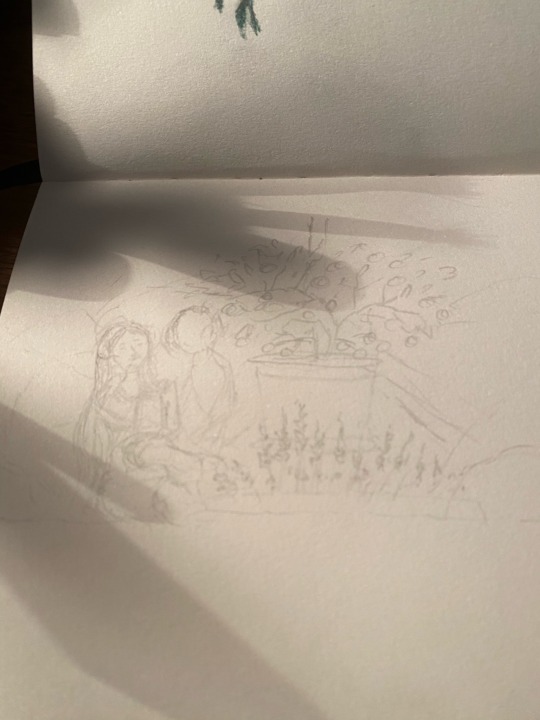
Sketching attempts/draft of the Tudors OT3 in the garden Henry had built because Thomas mentioned he missed Florence once because I searched Florentine Renaissance garden images and my brain went !!!!
#pending graphic tag#ot3: political power trio#lil and her ridiculous aus#thomas has his head in anne’s lap but I’m working on that!#(also perspective/proportion work in general! i need to go through more tips!)#me at my art class when it starts again: I have this vision um HELP#(me trying to explain it: I’m illustrating my historical fiction)
6 notes
·
View notes
Note
Im obsessed with your horseshoe crab bag and wanna make my own but dont have any leather working experience or knowledge, did you have a pattern you followed or did you just free hand it? also what would you recommend to someone wanting to try leather crafts for a first time?
I'll answer both this and a related question from @chaoticspaces:
hey! I’m in love with your crab bag. you mentioned you’ve never worked with leather; do you have any tips on where/how to start learning? or did you just wing it? I must preface that I’m a beginner at any sort of crafting and will have to learn the building blocks first but damn, people can just MAKE that kinda shit? I’ll learn to sew for that.
So it must be acknowledged that I am a fairly experienced crafter, I grew up sewing and sculpting and origami-ing and all sorts of crafty things. Meaning that although the horseshoe crab is my first experience in leatherworking, it's building off of existing crafting skills and experience thinking through how materials behave and how shapes interact. I say this as a preface not to discourage anyone from diving in, but rather so anyone who's newer to crafting can go in with a bit of perspective and not get discouraged if they don't get the hang of it right away! Be patient with yourself and keep pursuing the skills you want to develop.
With that out of the way, here's a (slightly abbreviated, but still Long) walk through what my process was like for drafting the pattern and learning how to work with leather!
Drafting the pattern
I started by looking up pictures of horseshoe crabs and doing a simple drawing of one from the top and from the side to get a sense of the shapes.
Then I broke it down into sections to make things easier on myself. Reducing things to basic shapes (crescent, box, wedge, cone, etc) is a good way to start making sense of a more complex form.
To make it work in three dimensions, I'd sketch what I think the shapes should probably be; cut out a mini version in paper; tape it together; go "hmm, that's not right," and adjust the sketch; repeat until I get roughly the form I'm looking for.
Once I had a general shape that worked, I recreated those pieces on paper again, this time full-size. That involved a lot of math to make sure all the proportions scaled accurately. Then I cut out those pieces and taped them together and adjusted any basic proportions again to fix anything that I scaled wrong.
At that point, I had a shape that read fairly well as horseshoe crab, and that would have been fine. However, I wanted things to curve and flare and be more organic, which is where a lot of the trickier adjustments come in. Using paper prototypes allowed me to work quickly and make changes easily. To exaggerate a curve, I'd cut the tape "seam", bend the paper into the desired shape, and then add or remove material from the adjoining sides until that curve stayed in place when re-taped. Each piece of the pattern is responsible for helping its neighbors stay in place.
After I got my paper prototype to a point I was happy with, I got some cheap sheets of kids' craft foam and made another prototype in that, but stitched instead of taped, in order to test the pattern as thoroughly as possible without having to use my actual leather for it.
---
Learning basic leatherworking
Youtube! I searched things like "introduction to leatherworking," "leatherworking techniques for beginners," "how to attach two pieces of leather," etc. There are a bunch of videos that show very detailed but not-too-lengthy examples of basic techniques.
Once I had seen a few examples and made a list of the basic tools I would need to get started, I went out and got myself some tools and scrap leather to experiment with. I watched some more videos showing how to use my tools, and followed along with them
Some of the techniques I looked up to start:
How to use an adjustable groover, stitching chisel, beveler, and wood slicker
Saddle stitching
Box stitching
Butt stitching (Yeah, I know)
How to set rivets in leather
What kind of leather dye/what kind of leather conditioner to use
I spent some time testing techniques, even ones I didn't need for this project, because the more time you spend with your material and tools, the more you'll understand how they work and how to get them to do what you want. I have a bunch of scraps lying around that just have random burnished edges, wonky rivets, stitches that don't go anywhere, etc.
I also found it helpful to look through leatherworking subreddits and follow leather crafters on instagram and look through what they're doing for inspiration, tips & tricks, and to see how they handle unusual shapes. Those subreddits can also be a good resource for finding existing answers to questions you have, or asking questions yourself.
47 notes
·
View notes
Text
once again i am answering asks in a big compilation post. included is... gotham, patrick stump, tips about drawing backgrounds, tips about drawing in general, links to my faq, and infinity train

like.... the tv series? No... I’ve drawn dc comics fanart before, though. But it’s been years since I’ve been really into it. I like jumped ship like 10 years ago when the New 52 happened LOL.

AFJHDSLKGH I’m sorry I (probably) won’t do it again??
Actually full disclosure I have a truly cringe amount of p stump drawings/photo studies in my sketchbook right now LOL. He’s just fun to draw... hats, glasses, guitar, a good shape... but I don’t think I’ll rly post those until I can hide them in another big sketchbook pdf.. probably Jan 2022. Stay tuned........ (ominous)
(ominous preview)
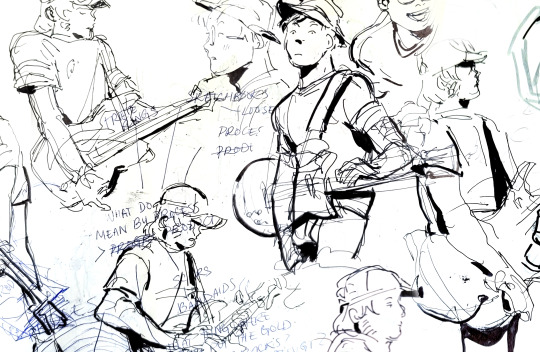

These are all sort of related to backgrounds/painting so I grouped them together even though they’re pretty much entirely separate questions.... ANYWAYS
a) How is it working as a BG artist? Is it hard? What show are you drawing for?
I think you’re the first person to ever ask me about my job! Being a background artist is great. It’s definitely labor intensive but I think that could describe pretty much any art job (If something were rote or easy to automate, you wouldn’t hire an artist to do it) and I hesitate to say whether its harder or easier than any other role in the animation pipeline. Plus, so much of what truly makes a job difficult varies from one production to the next, schedule, working environment, co-workers etc. But I will say that I think while BGs are generally a lot of work on the upfront, I think they’re subject to less scrutiny/revisions than something like character/props/effects design and you don’t have to pitch them to a room like boards. So I guess it’s good if you don’t like to talk to people? LOL
A lot of my previous projects + the show I’ve worked on the longest aren’t public yet so I can’t talk about em (but I assure you if/when the news does break I won’t shut up about it). But I’m currently working on Archer Season 12 LOL. I’m like 90% sure I’m allowed to say that.
b) ~~~THANK YOU!! ~~~
c) What exactly do you like to draw most [in a background]?
@kaitomiury Lots of stuff! I really like to draw clutter! Because it’s a great opportunity for environmental storytelling and also you can be kind of messy with it because the sheer mass will supersede any details LOL.
I like to draw clouds... I like to draw grass but not trees lol,,, I like to draw anything that sells perspective really easily like tiled floors and ceilings, shelves, lamp posts on a street etc.
d) Do you have any tips on how to paint (observational)?
god there’s so much to say. painting is really a whole ass discipline like someone can paint their whole life and still discover new things about it. I guess if you’re really just starting out my best advice is that habit is more important than product. especially with traditional plein air painting, I find that the procedure of going outside and setting up your paints is almost harder than the actual painting. There’s a lot of artists who say “I want to do plein air sometime!!” and then never actually get around to doing it. A lot of people just end up working from google streetview or photos on their computer.
But going outside to paint is a really good challenge because it forces you to make and commit to lighting and composition decisions really quickly. And to work through your mistakes instead of against them via undo button.
My last tip is to check out James Gurney’s youtube channel because hes probably the best and most consistent resource on observational painting out there rn. There’s lots other artists doing the same thing (off the top of my head I know a lot of the Warrior Painters group has people regularly posting plein air stuff and lightbox expo had a Jesse Schmidt lecture abt it last year) but Gurney’s probably the most prolific poster and one of the best at explaining the more technical stuff - his books are great too.
e) Do you have tips for drawing cleanly on heavypaint?
@marigoldfool UMM LOL I LIKE ONLY USE THE FILL TOOL so maybe use the fill tool? Fill and rectangle are good for edge control as opposed to the rest of the heavy paint tools which can get sort of muddles. And also I use a stylus so maybe if you’re using your finger, find a stylus that works with your device instead. That’s all I’ve got, frankly I don’t think my drawings are particularly clean lol.
f) Tips on improving backgrounds/scenes making them more dynamic practicing etc?
Ive given some tips about backgrounds/scenes before so I’m not gonna re-tread those but here’s another thing that might be helpful...
I think a good way to approach backgrounds is to think of the specific story or even mood you want to convey with the background first. Thinking “I just need to put something behind this character” is going to lead you to drawing like... a green screen tourist photo backdrop. But if you think “I need this bg to make the characters feel small” or “I need this bg to make the world feel colorful” then it gives you requirements and cues to work off of.

If I know a character needs to feel overwhelmed and small, then I know I need to create environment elements that will cage them in and corner them. If a character needs to feel triumphant/on top of the world then I know I need to let the environment open up around them. etc. If I know my focal point/ where I want to draw attention, I can build the background around that.
Also, backgrounds like figure compositions will have focal points of their own and you can draw attention to it/ the relationship the characters have with the bg element via scale or directionality or color, any number of cues. I think of it almost as a second/third character in a scene.

Not every composition is gonna have something so obvious like this but it helps me to think about these because then the characters feel connected and integrated with the environment.

Some more general art questions
a) Do you have any process/tips to start drawing character/bodies/heads?
I tried to kind of draw something to answer this but honestly this is difficult for me to answer because I don’t think I’m that great at drawing characters LOL. Ok, I think I have two tips.
1) flip your canvas often. A lot about what makes human bodies look correct and believable is symmetry and balance. Even if someone has asymmetrical features, the body will often pull and push in a way to counterbalance it. we often have inherent biases to one side or another like dominant hands dominant eyes etc. you know how right-handed artists will often favor drawing characters facing 45 degrees facing (the artist’s) left? that’s part of it. so viewing your drawing flipped even just to evaluate it helps compensate for that bias and makes you more aware of balance.
2) draw the whole figure often. I feel like a lot of beginner artists (myself included for a long time) defer to just drawing headshots or busts because it’s easier, you dont have to think about posing limbs etc. But drawing a full body allows you to better gauge proportion, perspective, body language, everything that makes a character look believable and grounded.
Like if you (me) have that issue where you draw the head too big and then have to resize it to fit the proportions of the rest of the body, it’s probably because you (I) drew the head first and are treating the body as an afterthought/attachment. Sketching out the whole figure first or even just quick drawing guides for it will help you think of it more holistically. I learned this figure drawing in charcoal at art school LOL.

oh. third mini tip - try to draw people from life often! its the best study. if you can get into a figure drawing/nude drawing class EVEN BETTER and if you have a local college/art space/museum that hosts those for free TREASURE IT AND TAKE ADVANTAGE OF IT, that’s a huge boon that a lot of artists (me again) wish they had. though if youre not so lucky and youre sitting in a park trying to creeper draw people and they keep moving.. don’t let that stop you! that’s good practice because it’s forcing you to work fast to get the important stuff down LOL. its a challenge!
b) I’ve been pretty out of energy and have had no inspiration to draw but I have the desire to. Any advice?
Dude, take a walk or something.... Or a nap? Low energy is going to effect everything else so you gotta hit that problem at its source.
If you’re looking for inspiration though, I’d recommend stuff like watching a movie, reading a book, playing video games etc. Fill up your idea bank with content and then give yourself time/space to gestate it into new concepts. Sometimes looking at other art works but sometimes it can work against you because it’s too close.
Also something that helps me is remembering that art doesn’t always have to be groundbreaking... like it’s okay to make something shitty and stupid that you don’t post online and only show to your friend. That’s all part of the process imo. If you want to hit a home run you gotta warm up first, right? Sports.
I should probably compile everytime i give tips on stuff like this but that’s getting dangerously close to being a social media artist who makes stupid boiled down art tutorials for clout which is the last thing i want to be... the thing I want to stress is that art is a whole visual language and there are widely agreed upon rules and customs but they exist in large part to be broken. Like there's an infinite number of ways to reach an infinite number of solutions and that’s actually what makes it really cool and personal for both the artist and the viewer. So when you make work you like or you find someone else’s work you like, take a step back and ask yourself what about it speaks for you, what about it works for you, what makes it effective, how to recreate that effect and how to break that effect completely, etc. And have a good time with it or else what’s the point.
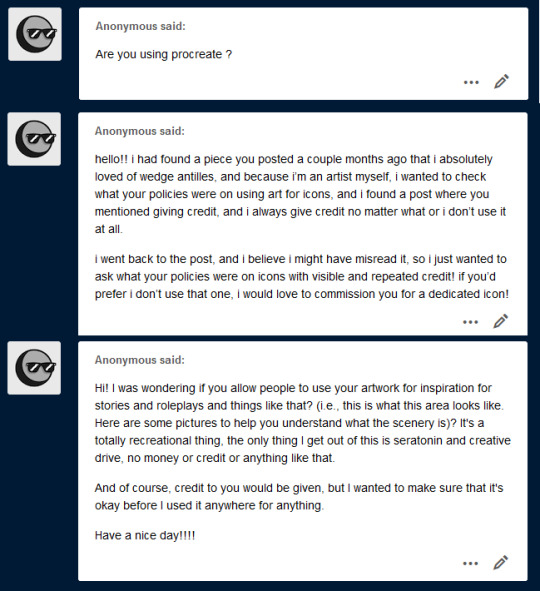
for the first 2, I direct you to my FAQ
For the last one, I don’t actually believe I’ve ever addressed artwork as insp for stories/rp but I’ll say here and now yeah go ahead! As long as you’re not making profit or taking credit for my work then I’m normally ok with it. Especially anything thats private and purely recreational, that’s generally 100% green light go. I only ask that if you post it anywhere public that you please credit me.
(and I reserve the right to ask you to take it down if I see it and don’t approve of it’s use but I think that case is pretty rare.)

a) @lemuelzero101 Thank you!!! I haven’t played Life is Strange but actually that series’ vis dev artist Edouard Caplain is one of my bigger art inspirations lately so that’s a really high compliment lol. And yeah I hope we get 5-8 too...!
b) Thank you for sticking around! I’ve been thinking about Digimon and Infinity Train in tandem lately, actually. They’re a little similar? Enter a dangerous alternate world and have wacky adventures with monsters/inanimate objects that have weird powers... there’s like weird engineers and mechanisms behind the scenes... also frontier literally starts with them getting on a train. Anyways if anyone else followed me for digimon... maybe you’d like Infinity Train? LOL
c) @king-wens-king I’M GLAD MY ART JUST HAS PINOY VIBES LOL I hope you are having a good day too :^)
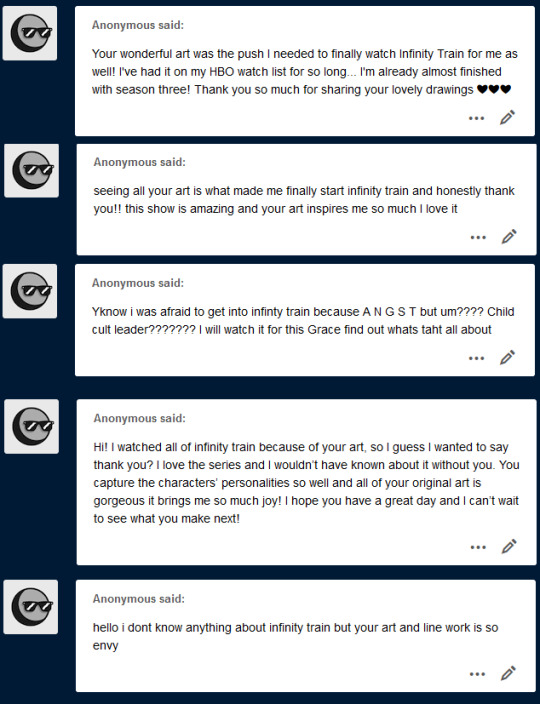
a, b, c, d) yessss my Watch Infinity Train agenda is working....
e) aw thank you!! i think you should watch infinity train :)
357 notes
·
View notes
Note
Do you have any tips for creating more dynamic/loose figures in art. Especially when drawing comic book characters
i mean, it's something i struggle with a lot and am still not very good at, so like... no. i definitely don't have any quick tips or cheats bc if i knew any, my art would look a lot nicer lol. that being said, i can share my sort-of game plan for practicing on my own
the first thing is that i need to have a better understanding of anatomy and the human figure. using references is fine and all, but i think we need to actually understand how the body is put together in order to use references more effectively. here's a link to a google drive folder full of art books, some of which do focus on figure drawing, that might be helpful. i might also borrow some books from my friend or take some out from the library, idk. this is probably going to be the most boring and time-consuming but i think it's important
to actually practice drawing dynamic figures, do quick gesture studies. and by quick i really do mean like 30 seconds to a minute on each figure. it's important to not get bogged down in details for these and really just focus on the expressiveness of the figure; keeping the line of action in mind may be helpful. speaking of which, there's a website actually called line of action that will generate figures at timed intervals for practicing this sort of thing, and there's also another pose generator for sketching here.
also, i think learning foreshortening and perspective will be immensely useful in creating figures that are less flat and more lively. personally i have no fucking idea about this and need to do more of my own research so yeah idk
i know this is a really boring answer, but seriously, it just boils down to practice. if you want to get good at something, you need to spend hours and hours practicing (i haven’t had time to do that, which is why my art is ... bad). maybe a more skilled artist could give some quick + easy tips, but first and foremost we really do need a genuine understanding of form and the human figure that goes deeper than just surface-level tricks!
also editing to add that the reason i’m harping on about the fundamentals so much even though comics art is not necessarily realistic is that once you have an understanding of how the human body works, you can stylize it from there and still have it looking good wrt proportions and all. for comics fans i’d specifically recommend reading understanding comics by scott mccloud, of which there is a pdf in the google drive folder linked above. his idea of amplification through simplification was really interesting to me!
5 notes
·
View notes
Note
did you ever furnish von osterly estate in your game? also do you have any tips for furnishing and building homes? I have a Pinterest board but nothing ever comes out
hi :) I remember fussing with a floor plan and throwing some furniture in there, but I don't have that build in my game anymore. but there is a floor plan and interior images for Osterley Park, which it was based on, in its section on my houses board on Pinterest! and you're in luck if you're particularly fond of that build, because it's the setting of a very sweet movie, The Grass is Greener, that shows you through the house. I also have a brand-new section full of floor plans (that I had previously kept private since they're not all from the period); anything is useful to get an idea of proportions, flow, and how spaces can be divided.
I'm not honestly sure I can give any tips that will help, but I can walk you through my process(es) and something might be of use! and my Pinterest has boards for interiors, residential exteriors, community lots, floor plans, furniture, and art, which I hope can be helpful! there's like three thousand pins total lol why am I like this
how I build:
> collect as many pictures as you can of a building, then pick a facade and go off! I tend to build a single wall as the front ground/first-floor facade and add windows and doors before building the whole shape of the building; it's easiest if you get a feel for the proportions first when you're working from an image, and then you can use that knowledge to add the other walls for that level, and then the other levels. using the window bays as a unit of measurement always helps me: you'll often have more than one of the same, so get that window and its surrounding walls right, then you can replicate that little room as many times as you need to fill out your walls. pay attention to stairwells, making sure you have reasonably-sized landings, a window for light/atmosphere, can get to each part of the house without too far a walk, all that. i like to have a shell of a building before i do anything else, and i try not to do too much laborious exterior ornamentsation before i try out a floor plan in case the room proportions need changing. > look up whether there's a floor plan or any architectural design drawings for what you want to build, because if there is you're in luck. you can use the room tool to make each of the rooms and then adjust them until they make the shape of the building; or inversely, get an aerial view of your lot and build the shape you see, then divide it into rooms according to the plan. when building shibden hall I went absolutely nuts and used the size in pixels of each room in the floor plan images to convert to numbers of in-game tiles each room should be - this is insane and you can totally just guess. once you've placed all interior walls, doors, and stairs you're in good shape.
how I furnish:
> once I have walls up inside the shell of the house, I place basic furniture in the rooms to denote what each room is (a bed, a couch, a desk, a dining table, etc). each room needs windows, doors, and a fireplace if it doesn't have them; then i start placing larger furnishings to create the layout of the room. it's easiest for me to go from the bigger things on down – placing sofas and coffee tables, then living chairs and end tables, then rugs and decorations. more historical building means keeping lighting (and heating/cooling) in mind: writing desks often go near windows, reading chairs go near fireplaces, and little tables, shelves, or torchères can go wherever your sims would need to see; and for homes classy enough to afford them, I tend to place wall sconces and chandeliers first according to the architecture of the bare room. outside-in is a good way to work if you can't visualize the layout of furniture: line the walls with bookshelves, cabinets, counters, fireplaces, mirrors, side tables, whatever; place chairs, tables, or sculptural pieces in front of windows; and then build in from there. since it's sims, I get kitchen (stove, fridge, sink, counter), bathroom (bath, sink, toilet), and bedroom (bed, dresser) squared away first so that all the necessary functions are usable. hypothetically, decor and clutter go last, but there are no rules in creativity ;)
general tips
when in doubt, do a bunch of googling/pinteresting, and then just copy what you see!
whatever inspires you will motivate you, so if a color scheme, furniture style, a set of CC, or any detail sparks joy, don't be afraid to start from there.
zoom out! when you're staring at a screen for a long time, ya lose perspective. literally zooming out and asking myself if where everything is makes sense always helps me.
if you're wondering why your build doesn't look quite right, the answer is usually proportions: changing wall heights, roof pitches, window sizes, and especially the wall length/amount of space between corners-windows-doors-et cetera (relative to the size of said architectural details) often fixes it!
watch filmed-on-location tv/movies and look up filming locations. built sets often have wonky unrealistic proportions and although interiors and exteriors are sometimes shot different places, a period piece shot in a real historic place gives you a feel for how spaces are lived in (plus it's fun).
did any of that help anyone? I can try to answer any question, the more specific the better, to the best of my ability!
14 notes
·
View notes
Note
Hello! I wanna start drawing again and I'm really fond of your style, I was wondering, do you have any drawing tips? ❤️
okay sorry this took a couple days to reply to because i wanted to think about it, but i think my main advice is to divide up your artistic time into practice and art. this drawfee video on how to practice effectively explains it really well (this section is at around 13 minutes, i haven’t watched the rest of it yet bc it’s a long vid but i bet there’s other good advice in there too): practice is input, drawing is output. practice is learning new information about things you don't know how to do – you're not making a final piece.
practice is things like:
experimenting with different ways of holding the pen/pencil. holding a pen/pencil for drawing is different than how you'd hold it for writing – you want to hold it higher up, and use looser arm movements. different angles will give different effects (see here). holding a pen for a tablet is different to both a traditional pencil and a writing grip. if you have a tablet that picks up on palm contact, try getting a drawing glove so that you don't have to hold your hand at an unnatural angle. draw different lines and shapes and get used to the different effects you can make.
experimenting with different ways of moving your hand. a general rule to follow here is the bigger the shape, the more of your arm you should use to draw it. a lot of people draw primarily with just their fingers or wrists moving because they feel more control there, which is great for fine detail work but doesn't translate well to bigger sweeping shapes, and thats where you end up with wobbly lines or having to draw several scratchy lines instead of one smooth curve. if you want more confident lines you need to draw from the elbow, or the shoulder. it takes some getting used to but it's definitely worth it for keeping your drawings lively instead of stiff, and your wrist will also feel less strain.
learning to draw basic 3 dimensional shapes. boxes, cylinders, spheres. just draw a whole lot of them from different angles.
learning how to break down a complex form into basic shapes. a good way to do this is tracing – tracing has a bad rap as being stealing, but as long as you're not uploading a traced image and passing it off as your own it's a great way to train your eye to understand how forms work together, particularly for something complex like anatomy. draw over an image and break it down into basic shapes. then try to copy those shapes onto your own paper without tracing. do it over and over until you're better at it. (this method of redrawing is called iterative drawing, it's a great practice technique).
theres broader practice and then narrow. having a mix of both is good: quick sketching a whole figure some days, other days really focusing in on like “this is how a nose work”. go with what feels right in the moment.
and then the output, the actual drawing, is when all this practice pays off - these are your pieces that you work on to show people, or the things that you want to make, this is where you chase your creativity and passion. keeping them separate really helps to stop your art feeling like a chore and keeps you from overworking your full pieces (incorporating too much practice into your creative art); it also stops you stagnating or becoming frustrated with your lack of improvement (not practicing enough).
you don't have to be super strict with yourself about when to do which thing; you'll probably go through phases of doing a lot of practice, and then phases of doing a lot of drawing. if you're really struggling with one thing, that's often a sign that you need to do more of the other to balance things out.
other advice:
learn to be bad at art. this is good during practice with things like timed figure drawing or whatever where you just don't have time to make it good, but it's also good in drawing/creating: just letting yourself make “bad” or silly or quick things for the fun of it or to get an idea out. nothing has to be perfect and the earlier you learn to be bad at art the quicker you'll get good at art, and the more you'll enjoy it too
to expand on that, while tablet drawing is great, i've found that i improve a lot more rapidly when i do at least some of my practice a) on paper but also b) in pen or marker or paint, anything non-erasable. the ability to undo and erase infinitely in digital art is great for full pieces but doing your practices in pen means you're forced to be lot less precious and so you learn quicker how to be more decisive and confident with your lines because whatever you put there, you’re stuck with it.
if you're stuck, try something completely out of your comfort zone. use different materials, restrict yourself to a specific colour palette, ask for prompts, set a timer. sometimes there's just too much choice about what to do and it can be paralysing: giving yourself a totally arbitrary restriction can actually push you to be more creative and to get out of a rut (recommending more drawfee here, their random shapes challenge videos are a really good example of this)
you don't have to find your style. it'll find you. it's good to observe what you like about other people's art and try to consciously think about it, it can be really good to ty and mimic those elements yourself during your practice, but for your actual drawings you don't need to think about your style because as your ability improves it will come out naturally.
this applies mostly to traditional, but try to have your paper tilted slightly rather than flat on the desk – i prop my hardback sketchbooks up on a book. if you have your paper flat then you're more likely to get a little bit of a perspective distortion from top to bottom, especially if you're working from a reference, because you're looking at the paper from a different angle than you're looking at the reference so it can look fine when you're drawing but then when you look at it head-on it's just a little off. it also makes it easier to not hunch up over it and get a backache.
FLIP THAT CANVAS. i don't know why this works but its a time-honoured artist technique for making sure that there's reasonable symmetry especially for drawing people: draw your picture out, then flip it. you'll be able to see a lot clearer where the proportions are off. make changes, flip it again, keep doing that. it's harder with traditional media to do this but if you have some tracing paper you can turn that over, or just take a photo of your work and flip that.
a little frustration can be good if it’s motivating you, but if it's so much that you're tearing up your drawings or wanting to quit, you either need to change up your approach for a while or you need to take a bit of a break. i know people say you have to draw every day and if that works for you then do that, but personally, i don’t: i go through phases of drawing all the time then not at all for a few weeks, and that works better for me than forcing myself to work on it every day and i often come back to it a lot better because i’ve given all the practice time to actually sink in. breaks are an important part of learning, whether its hour or a day or a week of just walking the fuck away from the sketchbook and doing something else.
stretch your arms and wrists often, especially if you're drawing for several hours. here's the routine i use, it’s only ten minutes but it makes a big difference. and if you've overdone it and your hand or wrist or back is hurting, don't push through it. drawing is surprisingly physical and i’ve fucked my hands up real bad several times not listening to a slight ache and having it turn into full on RSI
i hope some of that helps! there are a lot more specifics i could get into about a million different things but the overall gist of this is that you should be aware of all the different options you have and can dabble in, and try to find a balance of learning and creating that allows you to improve without sucking all the joy out of it.
15 notes
·
View notes
Text
Virgil’s story for FABFiveFeb
This is based off a Whumptober story I wrote, “A different perspective of ‘I Can’t Walk’,” but this one from Virgil’s point of view regarding Gordon’s surprise prank on Virgil. You don’t have to read it though to enjoy this story. The names of the locations are current.
Virgil prompts: “I’m trying,” shimmer, duck, hard.
***********************
Virgil smiled as he finished the last few strokes of his charcoal sketch. It had been hard to get that detail of the AutoZone Park’s Christmas tree in proportion, but he had to admit it was nice to sketch one in front of the Minor League baseball stadium in Tennessee.
Hard for him to believe it had been just four and a half hours earlier he had finished his 10K race with his brother Alan.
Scott had completed the full marathon and was likely still finishing up his deep tissue massage in The Peabody’s Spa.
The artist himself had taken a nice long hot shower and was now in his robe and boxers, drawing.
Gordon and John and finished the half marathon about two hours ago, and were doing their own recovering.
Virgil chortled at the last part: Gordon had bet John about whether or not he could complete the half marathon - and lost.
The look on Gordon’s face losing still made him smile, especially with John finishing it with an injured ankle falling into a pothole…
“Speaking of which,” he muttered, and got the mediscan out. John was napping in his room in the suite.
The astronaut said his ankle wasn’t bothering him anymore, but if there was one thing Virgil learned from his brothers, it was adrenaline was going to come into play. He was already going to feel the pains from lactic acid walking 13.1 miles, but if his ankle was hurt worse…
Virgil shook his head at the image of John grumbling as he was being carried, and quietly walked into the room.
John was still resting on top of the bed, pretty much dead to the world as he slept from the long walk. The medic was proud of his middle brother, especially all the training he’d done to win the bet.
But at the same time, he winced at the fact John was still in his astronaut themed sweats, which could be a sign his ankle hurt.
Virgil then gently turned on the scanner, letting the blue light scan over the younger man’s right ankle.
“Virg… you’ve got to stop doing that,” muttered a voice.
The older man looked up and saw that John was wide awake, glaring at him. “That’s the fourth time you’ve scanned my ankle since the race was over,” the ginger headed man said, annoyed.
“I just want to be sure there’s nothing torn in your ankle,” said Virgil, who finished the scan and looked at it. “It was a pretty hard fall you took.”
John sighed and stood up. “Yes, I know, but I feel better,” he said, gently leading his brother out.
Virgil frowned. “You’re limping,” he pointed out, unconsciously starting to do a sing-song voice.
“And I said I’m fine,” responded John as he pushed the man out, complete with a swift, and hard kick in the backside with his injured ankle.
Virgil turned around shocked by the fact his normally quiet, calm brother just put his size 12 grey and silver running shoes to a different use.
“See, perfectly fine,” said John cheekily as he walked a bit like a penguin across the room. “Look, I’m going to go look around the hotel lobby. EOS wanted me to show her the gingerbread village. You can come if you’d like, just don’t bring the scanner. Don’t want to send you home the hard way...”
Virgil waved the man off saying he’d join them later.
He watched as John left, and when the door closed, rubbed his backside…. “I’ll show the Astronaut the way home to Five the hard way,” he muttered.
A lighter snort filtered through his ears, making the man groan. “Gordon… if you say one word…”
The aquanaut choked back a laugh. “I won’t - it would be fun to see you try it, would keep me from having to pay up that bet,” said Gordon. He sobered up. “But John is OK, right? I’d hate he hurt himself worse over a wager.”
The medic looked at the scan and then smiled. “Yeah, he is. Just a twisted ankle, so I don’t need to do any more scans,” he said.
“Good thing - I think John is to the point he’d use the Vulcan Nerve Pinch to keep you from scanning his ankle,” said Gordon, smirking.
Virgil glared at the man. “No thank you… he’d probably succeed in knocking me out,” he said, walking back over to his sketch.
Gordon looked at what was being drawn, then smiled. “Looks nice. Going to keep working on your sketch?” he asked.
“Yes, why?”
“No reason. I’m going to go down to the lobby and chat with John,” said Gordon.
“You mean try to get him to let you welch out of your bet?” said Virgil with a smirk.
The aquanaut shrugged. “Maybe… but even then, I want to tell him how proud I am of him,” he said with a smile. “I’ll see you in a little while.”
“Yeah, see you in a little while. We’re still eating at Huey’s right?” said the older man as he started to sketch the skyline around the stadium. He loved the restaurant’s burgers and onion straws.
“Oh yes… don’t forget to dress up,” said Gordon, who then laughed.
Virgil rolled his eyes, but nodded and watched his brother head out. The door closed, leaving Virgil surrounded in the soothing pale Tiffany blue shaded walls and duck themed decorations.
He sketched for a while, finessing the details in his drawing, which now included his brothers. Each of them had worn unique outfits for their race… well except Scott, who preferred the event’s race tank and then fairly short running shorts. “At least he has the kind with the running bloomers,” Virgil thought with a chuckle.
The artist was so engrossed in his work he at first didn’t hear the knock at the door. When a louder one finally drew his attention, Virgil put aside his drawing and then opened the door.
Outside was a Peabody bellhop with a package. “Mr. Virgil Tracy,” he asked kindly, and Virgil nodded before he was handed the bundle. “You have been selected to be an honorary Duckmaster this evening. You need to wear this and come down about a quarter before 6 p.m.”
Virgil quirked an eyebrow, but then chortled. “OK, I’m honored. Thank you,” he said, and after giving the bellhop a generous tip, he brought the box to his room.
He then laughed. “Honorary Duckmaster? I don’t believe it,” repeated the artist as he looked at the card. Sure enough, someone had bought him the honor, something he admitted he wanted to do when he was younger.
Earlier on the trip in Memphis, the brothers had gone to the top floor to look at the Duck Hotel, as well as view the skyline. Virgil alone had several photos of the city as well as the hotel he was going to use for future artworks.
Duckmaster was something different however. had always pictured himself in the sharp red jacket, complete with epaulets, cords and black trousers, leading the ducks around with his Duckmaster cane and taking them up and down the elevator every single day.
Probably explained why he wished Gordon would refer to Thunderbird Two as a duck and not a frog.
Today, he thought as he opened up the package, he was going to get to wear that outfit, and…
His mouth dropped open when he saw what was inside.
“GORDON!”
8888888
Well, it was either do this or go down in his boxers and robe. Gordon had taken every piece of clothing he could from Virgil’s suitcases, but at least let him have the pair of underwear he brought into the bathroom.
He admitted he considered the alternative, but really, Virgil wasn’t going to do that.
Grandma Tracy loved coming to the historic hotel and eating their Banana Oreo Cheesecake, and he enjoyed his cup of coffee sweetened with just a bit of Tennessee honey he only found there.
It was a pair of treats for both and he wasn’t going to risk them getting banned due to a prank.
So, “swallow my pride, step out of the elevator and meet up with the Duckmaster” became his mantra as he entered the main lobby.
The Duckmaster, a kind man with dark hair and brown eyes, looked at Virgil a bit in surprise, then mellowed into a smile. “I see you’re very much the duck enthusiast,” he said kindly, but with a soft chuckle at the sight.
Virgil snorted, which made some of the ducks on his Hawaiian shirt shimmer as the metallic threads hit the light. “Oh yes, my brother knew I had dreamed of being a Duckmaster… I just didn’t expect my outfit to be a kilt and Hawaiian shirt,” he said. “Especially with the ducks having their own shimmering shirts…”
“The slippers are a nice touch,” said the older man with a twinkle in his eyes. He wouldn’t admit it to the slightly embarrassed man, but in his 20 years as the Duckmaster, he had seen a few unusual outfits.
Virgil’s duck overloaded outfit surprisingly was a bit tame to several. If anything the top, if longer sleeved, would fit in the Lansky Bros. Store, one of the hotel’s shops.
“I’m trying to figure out how Gordon managed to find character bedroom slippers in my size,” said Virgil as he took a step, watching the fabric mallard heads bob up and down.
“Not here… though I bet the gift store would like to know,” quipped the Duckmaster, who then smiled. “You look great though, and we’ll make the ceremony even more fun. So ready?”
Virgil saw the sincerity in the man’s eyes, and smiled. “Yes, ready,” he said, as they walked to the fountain. Nearby, Virgil caught the tri-colored blue, yellow and orange shirt that belonged to their favorite human fish - Gordon. Predictably, the aquanaut was already laughing, though Virgil admitted he couldn’t tell if it was from the sight or the Long Island Tea the aquanaut was drinking.
“Seriously… he knows better than to drink even a beer after a half marathon,” Virgil muttered, but seeing the man had also purchased what appeared to be a sandwich from the Peabody Deli, sighed in some relief Gordon was being a bit more cautious.
Next to him was John, who had snuck back to change out of the sweatpants but still wore the NASA patch shirt. The astronaut had a shy smile, enjoying the prank Gordon set up but still sympathetic. He did however roll his right ankle to show yes, it was doing well.
Looking up, Scott and Alan were found in the gallery above, having an excellent view of the scene. Alan was cackling at the sight, and while Scott cuffed his younger brother gently over the head, his eyes sparkled in merriment.
He had to admit, the silly outfit was worth wearing for his brothers’ reactions.
“Yeah, I’m ready… let’s show them how Duckmasters do this,” said Virgil with a chuckle.
The elder man clapped a hand on his shoulder with his own laugh, and started the presentation.
Weird outfit and all however - especially the shimmery top, being an honorary Duckmaster was worth every cent for Virgil as it was for Gordon to prank him.
8888888
About a half an hour later, Virgil sat in the lobby with his brothers, enjoying a cup of hot Earl Grey tea before he dug into his Equinox dessert. He relished the taste of hazelnuts, chocolate cake, and ganache.
He first looked at the Duckmaster cane and special rubber duck he received as part of the package, then looked at Gordon.
“Why a duck kilt Gordo?” he said. Of the three items, he was most embarrassed about the kilt. The shirt at least got him a phone number of one girl who found it hot on him, and the slippers were actually quite comfortable. He just wished they didn’t have the knitted cuffs at the ankles.
The aquanaut shrugged as he took a bite of his chocolate Peabody Duck. “You needed to match: I have a squid kilt, Alan a rocket kilt…”
“But Gordon, Scott and I don’t have one,” said John, who hiccupped slightly. “You know better than to not get me one…”
Scott rolled his eyes. “And you know better than to have more than one Old Dominick,” said the eldest, gesturing at the glass of bourbon. He was enjoying a cup of coffee and a chocolate dome, having to refrain from alcohol. It was nice of John to make Gordon pay for a plated dessert for all of them as part of the bet forfeit, but he still had to fly them home tomorrow.
“I only had two,” said John, who hiccupped again. “Though yes, maybe one would’ve been enough.”
Virgil chuckled. “Thankfully, we’re going to still go to Huey’s, so you can get a burger and soak it up,” he said gently. John nodded, admittedly confused they’d eat dessert first, but thankful they were wise enough to still eat something more substantial.
Gordon laughed. “Rate he’s going he’ll forget the ice cream tomorrow,” he said. “I can welch a bit…”
Scott shook his head. “No Gordo… you promised, and I’ll make sure of it,” he said.
“Even if he eats it on the airplane?”
“Oh no, that isn’t happening…” said Scott, who seeing Gordon nearly cheer in victory continued. “Not until all five of us eat a cone. I want to try that Equinox ice cream.”
“That's what I’m getting,” said John with a slightly brighter laugh, which the others joined in.
Scott, seeing the slight shimmer in John’s eyes, smiled. Poor guy was OK but he didn’t want to risk the twisted ankle become a sprain walking the one block over.
“I do think right now we go back to the suite and rest. Huey’s should be a bit less busy in an hour,” the eldest said. “And I for one want to eat their famous onion straws.”
The others nodded, and after paying their tab, went to the elevators.
Alan, Gordon and John took the first elevator, while Virgil and Scott took the next one.
The eldest looked at Virgil. “You do realize - phone number or not - you look ridiculous,” he said, chuckling. “Gordon got you good.”
Virgil gave a half smile and nodded. “Yeah, he did. But you know they say revenge is a dish best served cold right?”
Scott nodded, and frowned. “Virgil, you know he’s not embarrassed to wear anything weird,” he said, then tilted his head. “Or about not wearing anything at all…”
The second eldest smiled. “No, I won’t do that to him. I love Grandma too much to get us banned from The Peabody. Plus I like that honey in my coffee here,” he said. “I’ve got something better. An invasion.”
The eldest quirked an eyebrow, but then seeing Virgil pull out one of the two items he received as Duckmaster, smiled. “Oh no… you didn’t…”
“Oh yeah, tomorrow he’s about to go ‘quackers’,” said Virgil, who laughed when he saw his older brother do a facepalm at the bad joke.
“I’m going to need earplugs…” was all scott muttered.
8888888
That next morning, the sound of quacks filled the suite the Tracy’s were using..
Well, quacks made more of squeakers.
Gordon woke up to find his bed was nearly covered in rubber ducks, all from The Peabody.
They were also on the floor, bathtub, and toilet.
There was even a silver dollar sized duck someone managed to sneak into his reusable water bottle.
Some had shimmery tops on their body.
One was the Duckmaster duck - staring right at him when he awoke.
“Well played Virg,” said Gordon, with a smile.
He conceded defeat this time.
Now, there were only two things Gordon could do:
First, donate all but one or two of the ducks to St. Jude Children’s Research Hospital, now working to end even more diseases as they had most childhood cancers.
Second, find a way to pay back Virgil for the prank.
8888888
Reference of the Duckmaster ceremony (by me a few years ago). This is an honorary Duckmaster ceremony, and any age can do this:
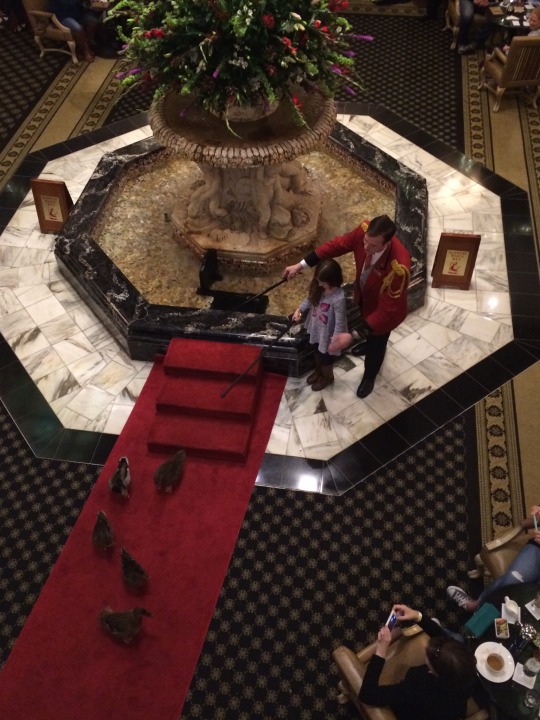
11 notes
·
View notes
Text
Do you feel anxious for no reason? Are you endlessly worrying unnecessarily about your health, finance or life? Are you having panic attacks? Are you constantly on edge and anxious to the extent you can’t even concentrate sometimes? Do you find it difficult sleeping every night? Do you dream so much that you wake up exhausted? Are you constantly judging and micro monitoring yourself? Do you feel lightheaded when you stand up? Are you so tormented by the feeling of anxiety that you think you may be losing your ever loving mind? If you have answered yes to any 3 questions above, chances are you are suffering from one of the many forms of a condition called ANXIETY.
I have chosen to write about anxiety and depression as both are something that has affected me in life, the effects of these two mostly mental conditions prompted me to look around my society and wonder, was I the only one to be affected by this? Am I a special case? my studies have allowed me to understand that depression and anxiety are so prevalent in and around Accra that, I dare propose that 7 in 10 men in Accra suffer from these conditions and it is worsened because most people won’t dare talk about it.
They wont want to talk about it for fear of people’s reaction to their condition or simply for fear that they may be losing their minds so they keep it to themselves. In Accra Ghana there is a stigma on mental conditions or disorder of any kind, so most men in Accra (Both Ghanaian and foreigners in the country) find themselves dependent on alcohol or other forms of self medication just to have a good night sleep or even maintain normal routine.
Why have I chosen Accra as an area for this case study, I live and work in Accra, so naturally this will be a good and easy place in which to carry out research. I dont want to talk about Kumasi or Takoradi because I do not live there, I have spent a lot of time in and around Accra, I have spoke to so many people about this topic, so everything I say here is in most cases word for word the experiences and feelings of too many men within Accra.
For most people the feelings of anxiety especially gets so intense that they even end up going to hospitals, only for the doctor to inform them there is nothing wrong with them.
In many cases these Doctors misdiagnose the patient not because they ran tests on the individual but because the person complains of sensations, without test or ignoring their test which shows clearly that nothing is wrong with the patient, they will place the patient on drugs. Many times they will place these patients on high blood pressure drugs which creates new problems for the patient or worsens the case.
WHAT IS ANXIETY?
According to WEBMD.com the most common form of anxiety is the Generalized anxiety disorder (or GAD) which is characterized by excessive, exaggerated anxiety and worry about everyday life events with no obvious reasons for worry. People with symptoms of generalized anxiety disorder tend to always expect disaster and can’t stop worrying about health, money, family, work, or school. In people with GAD, the worry is often unrealistic or out of proportion for the situation. Daily life becomes a constant state of worry, fear, and dread.
These generalize anxiety then produces symptoms for the individual that is called panic attacks, these panic attacks can be expressed in a verity of ways; The person can find themselves with racing heartbeats for no apparent reason, they can find themselves sweating in a heightened sense of anxiousness for no apparent reason, they may develop a fear of crowded places, They may develop a hyper dream situation were they dream so much night that it leaves them fatigued in the morning, they may also develop insomnia(sleeping disorder), many advanced anxiety sufferers tend to feel fatigued throughout the day, have a feeling that they may pass out at random times or they may develop a belief that they are losing their minds from the enter affair. Basically the feeling of panic attacks brought on my general anxiety disorder is one where the suffer feels a continued sense of anxiousness and this is a most uncomfortable state of mind to live in, it is paramount to a hellish existence.
In most cases anxiety sufferers find themselves falling naturally into depression.
WHAT IS DEPRESSION?
Depression is a common illness worldwide, with more than 264 million people affected(1). Depression is different from usual mood fluctuations and short-lived emotional responses to challenges in everyday life. Especially when long-lasting and with moderate or severe intensity, depression may become a serious health condition. It can cause the affected person to suffer greatly and function poorly at work, at school and in the family. At its worst, depression can lead to suicide.
The most damaging part of this anxiety problem in Accra is that most men are not even aware that they are suffering from it, so many of them tend to use alcohol as a way to remedy the sensations in the short-term.
According to Healthline Media on http://www.healthline.com, Alcohol is a sedative and a depressant that affects the central nervous system. The first few years or months of using alcohol to manage your anxiety, you will find that drinking alcohol can reduce fears and take your mind off of your troubles. But once drinking is continuous like it usually is, you can build a tolerance to the de-stressing effects of alcohol, and this can make anxiety and stress even more difficult to cope with.
I believe that this is the real reason for the high patronage of bars, hence its high availability all over Accra. You just have to look around you and you will be awestruck once you fully grasp how frequent you will come across a bar all over Accra. Even more surprising is that no matter how small, rundown, big or expensive a drinking spot appears to be, from Sunday to Sunday there will always be men and women drinking from Sunday to Sunday.
This slideshow requires JavaScript.
This is not to say that a culture of drinking alcohol is innately bad but after talking to a few people, it has come to my knowledge that most men in Accra today are drinking as a way to cope with the anxiety of living and working in the system, as most men in Accra go to bed and wake up unsure of where the next meal will come from.
Office workers in Accra account for about 30% of the workforce in Accra, the rest are small to medium scale business owners and business men engaged in many different businesses to make honest living. 90% of men in Accra including the office worker go through unbelievable stress that in most cases will cause anxiety and depression, as the system is one that we find constant inflation but the salaries and earnings seem to remain the same or in some cases even reduce.
Most men in Accra even those with wife and children go to bed and wake up with no idea where their next meal will come from, no retirement funds, no social structure that guarantees the children’s education, everything is depended on what the man of the house can bring home. It is sadly expected that this level of stress naturally will be attracted to men in a system like this.
Now we must understand that Ghana in particular is a system that does not really care about the well being of the individual human being, I mean this in the sense that we have no provision for human stress relief, no parks, no programs created with the sole intent of reducing stress or mental trauma in the system, this is the same issue in Ghana’s immediate Brother nation; Nigeria. All we have are the drinking bars and clubbing joints, it is only natural that most men within Accra will turn to alcohol as the major form of stress relief.
Most sickness that men suffer from within Accra can be attributed to an extra-ordinary consumption of alcohol and high stress, these two issues I feel are expressing a prior condition in men that the medical system in Accra have largely ignored. Anxiety can lead to excessive drinking, Anxiety is also a signal that your stress factor is out of control, I feel that if the medical system can start to treat anxiety as a serious issue and look for proper remedies for it, many men and women will be saved from more critical conditions that can come from drinking, high blood pressure brought on through stress of anxiety and also depression which can lead to suicide. I hope this article can open the eyes of all the readers so we can begin talking about this issue, and subsequently pressure our government into doing the needful to help the overwhelming amount of people in society suffering from anxiety.
14 TIPS TO HELP YOU CONTROL YOUR ANXIETY
Take a time-out. Practice yoga, listen to music, meditate, get a massage, or learn relaxation techniques. Stepping back from the problem of life helps clear your head.
Eat well-balanced meals. Do not skip any meals. Do keep healthful, energy-boosting snacks on hand.
Limit alcohol and caffeine, which can aggravate anxiety and trigger panic attacks.
Get enough sleep. When stressed, your body needs additional sleep and rest.
Exercise daily to help you feel good and maintain your health. Check out the fitness tips below.
Take deep breaths. Inhale and exhale slowly.
Count to 10 slowly. Repeat, and count to 20 if necessary.
Do your best. Instead of aiming for perfection, which isn’t possible, be proud of however close you get.
Accept that you cannot control everything. Put your stress in perspective: Is it really as bad as you think?
Welcome humor. A good laugh goes a long way.
Maintain a positive attitude. Make an effort to replace negative thoughts with positive ones.
Get involved. Volunteer or find another way to be active in your community, which creates a support network and gives you a break from everyday stress.
Learn what triggers your anxiety. Is it work, family, school, or something else you can identify? Write in a journal when you’re feeling stressed or anxious, and look for a pattern.
Talk to someone. Tell friends and family you’re feeling overwhelmed, and let them know how they can help you. Talk to a physician or therapist for professional help.
Are you suffering from anxiety? How do you handle the condition? Please share with us below.
Sources:
ANXIETY AND DEPRESSION ASSOCIATION OF AMERICA
HEALTHLINE MEDIA INC
WEBMD
ANXIETY the BIGGEST PROBLEM that MOST MEN in ACCRA GHANA don’t know they have! Do you feel anxious for no reason? Are you endlessly worrying unnecessarily about your health, finance or life?
2 notes
·
View notes
Text
𝖁𝖎𝖘𝖚𝖆𝖑 𝖘𝖙𝖚𝖉𝖎𝖊𝖘 | 02/12/19
Artists and terms; at this point we should have begun this and should be able to define the terms from this brief.
Structural box sketches (Looking at human anatomy at its simplest form looking at joints and pivot point refer back to ROTOSCOPING on this.); how do we further develop them? - By trying out different stylistic features and outfits. Make a turnaround. Redraw! Moving the character.
What do we mean with fantasy quest, refer to the “detailed description”.
What is a narrative?:
It’s how a story is told. Who? It is told to an audience. The beginning, the scenario is set up. Why is a narrative different from a story? The story is a subjective opinion about what's happening, whereas the narrative is more of an objectified version of that. Jack walks up the hill; story, Jack has mental problems, narrative.
Within animation & illustration let us consider that; a narrative is how a story is constructed & organised. This means how the information is then relayed to an audience, and in what order.
𝕿𝖆𝖘𝖐:
Look at images, construct a narrative.
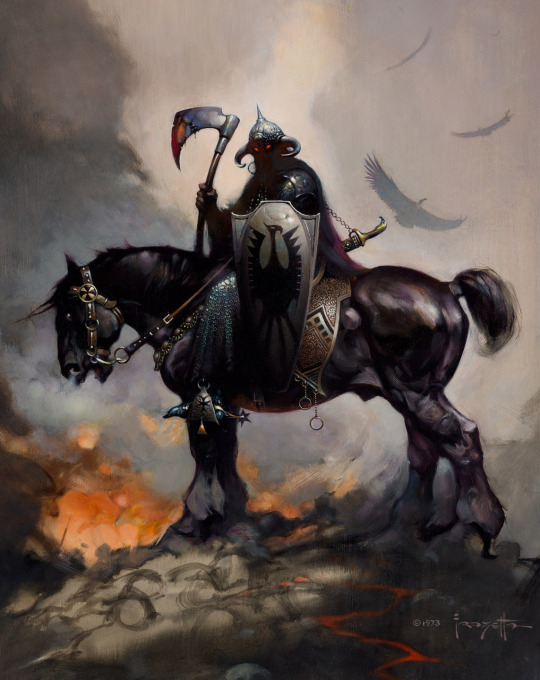
𝕱𝖗𝖆𝖓𝖟𝖊𝖙𝖙𝖆
After an intense bloodthirsty battle, the last warrior stands. His power immense, his life eternal.
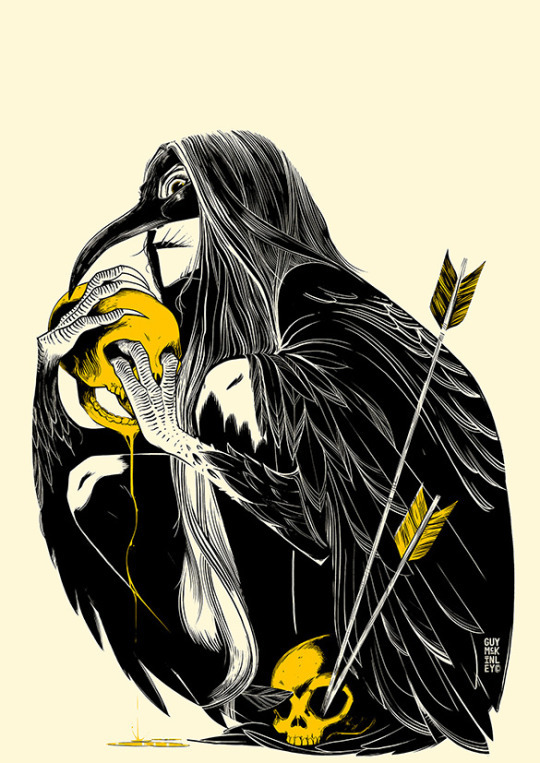
𝕲𝖚𝖞 𝕸𝖈𝕶𝖎𝖓𝖑𝖊𝖞
The skulls of the battlefield are collected by witches of the woods, used for spiritual rituals as the fallen souls are attached indefinitely to their severed heads.
So what is narrative theory?
Exposition -> Rising action -> Climax -> Falling action -> Denouement
Exposition: This is where the characters of the story gets introduces alongside the story and plot itself. This is often the most difficult part to set up successfully, simply because you need to capture the readers/viewers/target audiences’ attention and have then clued in on what’s going on in the story, but this has to be done without completely spoiling the rest of the story. It is important to not mistake exposition and an info dump.
The characters: Who are the characters? How do you differentiate them from each other? What makes them interesting?
The setting/context: Where does the story take place? When does it take place at? What time period?
The mood: What tone is conveyed during the exposition of the story?
Rising action: This is the moment where the plot and narrative starts picking up. Rising action is usually encouraged by a key trigger, which is what tells the reader that “now things will start to take form.” This key trigger is what rolls the dice, that then causes a series of events to escalate to then set the story into motion.
Climax: A climax builds upon everything that has been introduced during the exposition and rising action. This is the moment of truth for the protagonist and the peak moment of the story. You know the plot is successful at delivering a good climax when the outer journeys and the inner goals of which the protagonist wish to complete click.
Falling action: So, what now? You’ve technically finished the story. Finishing a story after a climax or during one is what is known as a cliff-hanger. Cliff hangers work well in film series, but they don’t feel as satisfying. A way to see falling action could be as the old saying; “What goes up must come down.” Putting together any hanging threads not yet solved in the plot is done during this stage.
Denouement: Denouement (resolution) is a fancy way of saying that the story is about to come to an end. At this point, all questions are resolved and answered; letting the reader.
𝕿𝖆𝖘𝖐:
BBC animation defining the narrative, look for new terms and note them down.
All media texts tell a story. The narrative is about how a narrative unfolds
Story arc (transition from beginning to end)
stage 1
Stasis, setting up the story and meeting the protagonist, everything is normal at this point. This can be related to exposition.
Stage 2
“Trigger” that sends things in motion. creating the root for a fantasy quest to overcome and solve. This can relate to “rising action”.
Stage 3
Surprise! This moment can also be described as an obstacle of sorts.
Critical choice - high drama and stress. This reveals to the audience what kind of character they are. This is also considered part of the rising action.
Stage 4
The climax - The resolution of the conflict. The buildup of the whole story comes to this moment.
Stage 5
Reversal; character realises they're not useless. They change the character; develop them. Related to the denouement.
𝕭𝖊𝖆𝖘𝖙𝖘
Visual studies
Looking -> Doing (draw)
Repetition is incredibly important to ensure accuracy is portrayed within a study.
In the beginning, we are looking at tonal values. We are doing this with the help of skulls;
But why specifically skulls? Well, they are symbolic/iconic in the history of art. It symbolises death or a new beginning after an end within storytelling, thought in storytelling it can also symbolise a worthy trophy or token. This ties in well with the theme of narrative, world building and character creating using the theme of fantasy.
𝕿𝖆𝖘𝖐 𝖔𝖓𝖊
For this, a selection of different skulls were places on tables around the classroom. We were to select any of these to begin drawing by using the “drawing - looking” technique, ensuring that we are observing rather than drawing from our imagination. It was important for use to find a good angle; not too close to the object. If we were to sit too close to the subject, it would be more difficult to see the subject as a whole. This exercise is not focused on capturing detail, but rather it focuses on being able to capture the essence of the object/main subject. On another note, the perspective of light and angle is important in visual studies. This is what changes how your outcome is going to come out. So with all of this in mind, we began by choosing to work with either chalk or graphite, staying be loose and light while sketching.

In order, there were the three different visual studies that I did of the human skull:
1
In this one, I simply just focused on letting go, not focusing too much on capturing the little detail of the skull, but just making sure that I have gotten the basic shape accurate to what I was seeing before me.

2
For the second attempt, I changed the angle to see how the light was changing.

3
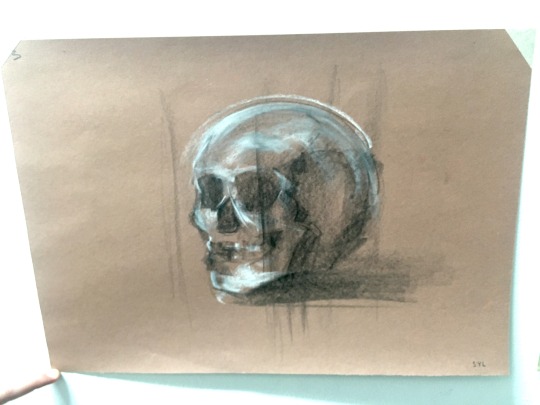
𝕿𝖆𝖘𝖐 𝖙𝖜𝖔
So during the first task, we took a more traditional/analogue route. During the second task, we were introduced with the ideas of expanding upon this exercise; further experimenting with mediums and techniques to see how far you can push the limit of what is possible.
I decided to try out using some felt tip markers; It’s probably the medium I am most insecure about using, so I thought it would be suitable to challenge myself.
I taped together two markers; a pink and a light green. On top of that, I tried drawing the skull in front of me (from different angles every time) but with a twist each time; sometimes I’d draw while only looking at the skull, but not down at the paper. Other times I tried drawing the skull without looking at all. It gave some interesting results;
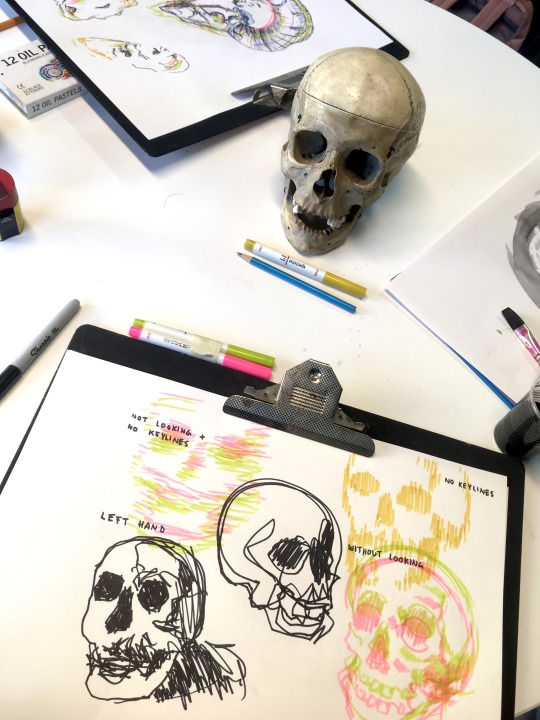
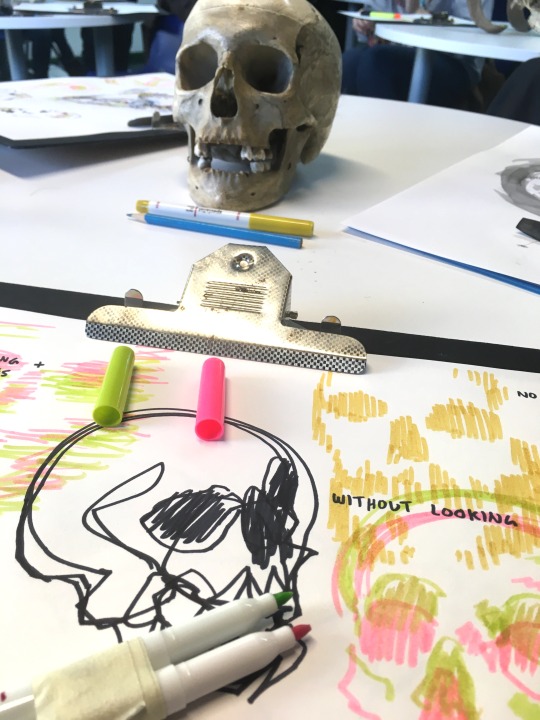
Here are the some pictures showing the two sheets of paper at the end of the lesson and exercise:
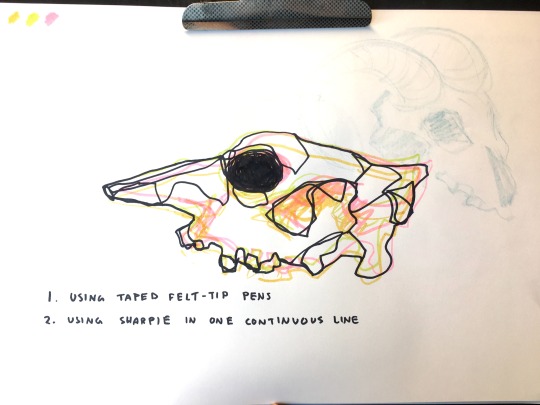

But before the lesson ended, we went over some evaluation by looking at what everyone had created;
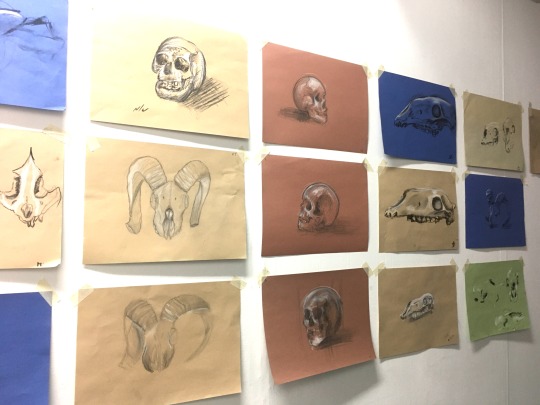


Pour Quoi?
Shows how you are developing drawing skills from observation (looking & doing)
Shows that you are a diverse practitioner and can embrace all media, especially through traditional approaches
Generating ideas from primary sources enables you to show higher-level approaches to research
What now?
Using these observational sketches, I can develop ideas for a character or character accessory.
I can ask myself question based upon this exercise ie. “What role could the skull play in communicating a narrative idea or theme?”
After this exercise, I decided to further have a play around with the concept of looking and drawing. I found a video of a 3D horse skull made by “handpuppe” on YouTube. Here’s a gif of the video:

Using this for reference similarly to what we did in lesson, I began drawing some of the frames at random, using the method of looking and drawing repeatedly. Below are the tree visual studies that I did, all three drawn from different angles.
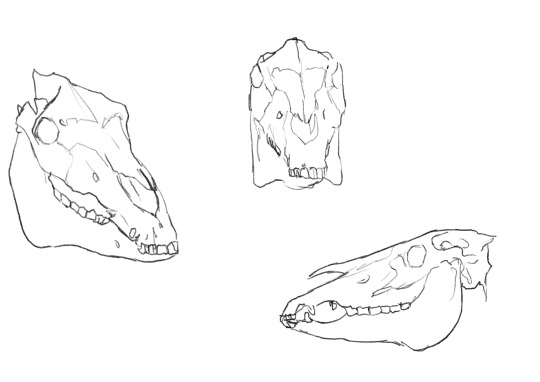
I didn’t want to just leave it here. Since this counts as being primary research to some extend, I wanted to build upon that. I decided to do this by using the anatomy of the skull to draw the horse on top of it on separate layer, allowing me to get the proportions anatomically correct.

Here is the finished result of this little side experiment:
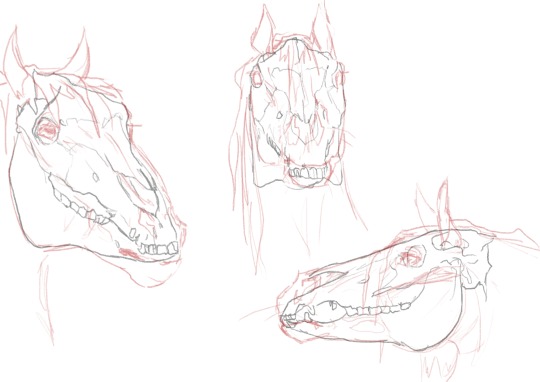

I found that this really opened my mind to understanding how useful it can be to sit down and just do some visual studying and researching. It helps to further improve one on a skill level, but also just to understand how anatomy or the form of a subject is built up. It’s not exactly a thing you actively think about on the regular, so it is very refreshing to do this kind of drawing now and then. I will be sure to try and do this more frequently for these reasons, potentially using it as a way to warm up before starting some more “serious” work.
2 notes
·
View notes
Text
The Art of Deescalation
“I WANT TO SPEAK TO YOUR MANAGER!”
“CANCEL MY CONTRACT!”
“I WANT MY MONEY BACK!”
We’ve heard it before. It’s uncomfortable. It’s challenging. And it’s the antithesis of customer success. In this post, we’ll explore tried and true methods to calm your angriest customers down and win critical customer success conversations.
Introduction
By its nature, the goal of customer success is create win-win situations between your company and your customer. It’s through these win-win situations that we as customer success professionals guarantee retention and the opportunity for additional revenue streams from our existing customer base. Almost inevitably for any product at scale, some customers will feel your product did not meet their needs. When this occurs, it’s only natural for the customer to get angry... and, in the case of the most valuable products, very angry. That said, navigating and winning deescalation scenarios with customers is a vital skill of any customer success professional.
Deescalation can be thought of as the process of bringing a customer down from an elevated negative emotional state to a calm, confident state where they continue to use your product into the future with comfort and confidence. Deescalation is not just tricky and taxing, but vitally important. A customer escalation is often the most telltale warning sign of customer churn, and preventing churn is the most central goal of most CS teams. After all, in study after study and industry after industry, it’s proven to be more efficient to retain customers than to acquire new customers. Deescalation is our core method of retention with upset customers.
Deescalation requires careful planning, precision, and practice. While deescalation might seem to be common sense to the bright-eyed and bushy-tailed CSM, it’s easy to forget common sense or miss vital deescalation steps when push comes to shove. As Mike Tyson put it, “Everyone has a plan until they get punched in the mouth.” Deescalation is no different. With this guide, my hope is that you will have a go-to plan to deescalate your most ornery customers, regardless of how hard they punch you in the mouth. Specifically, my ultimate goal is to provide a checklist you can print and keep at your desk for difficult situations moving forward. If checklists are good enough to take off and land an airplane, they’ll be more than enough for our purposes in deescalation.
The canonical three-step method for deescalation for most customer success professionals is known as “feel, felt, found.” This method suggests we explain to customers we understand how they feel, that we have met folks who have felt this way before, and we have found that our solution is the best for their needs. In my experience, this method is useful. However, it needs a lot more detail to cover the full gamut of customer escalations. In this three-part blog, we expand upon this method in detail, adapting it for more nuanced customer scenarios. The purpose of this post is to focus on Part I: Feel.
Observation: Think of Deescalation as a Game
Deescalations used to drag me down and exhaust me. At one point, they made me reconsider whether I wanted to work in CS at all. Later on, I came to a realization that changed it all for me.
My outlook on CS changed when I realized: Deescalation is a game. It’s a very important and difficult game, but a game nonetheless. In this game, winning is successfully deescalating the customer and retaining revenue. Losing is the customer walking away feeling dissatisfied and potentially cancelling your product. Our goal is to win the game.
Thinking of a deescalation as a game objectifies the conversation. It puts you in a position where you won’t take even the meanest comments personally. This attitude helps you realize: you’ve been here before and you’ve survived. And while you will win some and lose some, your goal is to maintain a winning record in the long term.
In this game, you can think of calmness as the boundary lines. Losing your cool means you’ve stepped out of bounds, failed on the play, and need to reset for the next play. Going into calls with stressed or angry customers, I often repeat three times the motto: If I lose my cool, I lose.
It’s tempting to let anger and vitriol get under our skin. However, it’s the ability to withstand complaints that separates the strongest CS players from those who don’t generally make it in the service profession. It is imperative in the deescalation game to remain calm, cool, and collected. As an old African proverb states, “If there is no enemy within, the enemy outside can do us no harm.” These words should ring true to you long before you enter a CS deescalation conversation.
As soon as I came to the realization that deescalation is a game, I went into my next call with an angry customer with a renewed sense of calmness and composure. I recommend meditating on the same notion long prior to your deescalation conversations.
Part I: Feel
You have two ears and one mouth. Use them in that proportion
-Anonymous
In order for a customer to be willing to calm down, it’s essential for them to know that you understand them and are on their side. The primary mistake that leads to failed deescalations is a tendency for CS reps to either zone out and stonewall the customer or prematurely jump into solutions. Both options are a mis-step. The fundamental problem with these methods is that they do not prove your understanding.
A better method is to spend as much time as needed elaborating on how well you understand the customer’s need. While it may feel redundant, meaningless, or even counterproductive to spend substantial time elaborating on and validating the problem your customer is experiencing, demonstrating understanding of your customer is often a prerequisite to them opening up to your eventual suggestions.
In the “feel” stage of deescalation, our goal is to prove to the customer that we’re on their side and understand their needs. It’s not enough to understand where the customer is coming from, nor just to say you understand where they’re coming from. Rather, the customer has to believe you understand where they’re coming from. After all, from their perspective, if you don’t understand their problem, how good will you be at providing a solution? When the customer does not feel understood, they often feel the need to reiterate their need (often to the point of your annoyance) and escalate past you to your manager. In other words, a lack of understanding is a surefire way to end up 0 for 1 in the deescalation game.
The “feel” stage is made up of several steps, each with corresponding benefits and tips along the way.
Step 1: Before going in, remind yourself — you’re the customer’s best defense. Contextually-speaking, as CS professionals, we have to remind ourselves that we are the primary (indeed, sometimes the only) people in the company who will advocate for the customers. Although many companies differ in structure, in general, no one else in the company has strong incentives to fight on the customers’ behalf. Marketing, sales, product, or other departments have much different incentives than sticking up for the customers’ business needs. They also usually have fewer customer touchpoints, so the scope of their understanding is inherently more limited. When going into deescalation conversations, remind yourself that you’re the customer’s lifeline. In doing so, you’ll naturally gravitate toward a tone of forgiveness, partnership, and mutual benefit.
Tip: By priming yourself with these notions of advocacy and calmness, I recommend going into the conversation with surprising—even alarming—excitement. Bringing positivity to the table will often immediately disarm the customer. Try beginning a call by saying, “I’m so happy we’re getting the chance to chat!” within the first 30 seconds of conversation. Later, once they have stated their case, I also recommend stating, “I’m so happy you brought this up.” This positivity immediately catches the customer off guard and encourages them to reset expectations of the engagement. It sets the tone that prevents negativity from the get-go.
Step 2: Take charge without belittling the customer’s needs: In one minute, explain the parameters of the conversation.
My first failed deescalation calls often started off on entirely the wrong foot. I used to say hello, ask how it’s going, and immediately the customer would begin complaining. Caught on my heels, I would either scramble to take notes or try to lead calls with solutions that naturally did not align precisely with customer needs. After several calls like this in a row, I felt exhausted, useless, and disappointed. I began to zone out and stonewall the customer.
The lesson I learned is: In the first minute of conversation, clearly lay out the expectations for the call. Four components are key, which collectively allow you to take charge without belittling the customer’s needs:
Let them know who you are, what you can do for them, and more importantly, what you cannot do for them. Start by letting the customer know you’re on their side. Let them know the entire reason you were hired is to make sure their needs are met. This reassures the customer that you’re a tool for their defense, not their adversary.
It’s equally important for the customer to know what you cannot do for them. This is key in scenarios where customers ask for promises you truly can’t provide. Leading them on with false pretenses of your capabilities within your organization will often result in disaster. In my line of work, I tell people outright, “I’m your advocate here. While I’m not on the engineering team and can’t build any code, it’s my responsibility to see to it that your needs are met with the product as it stands now.” I also tell people, “I’m not in the refunds department. I’m in the customer success department. I have a lot of tools at my disposal, and though refunds aren’t one of them, I think we can come up with a plan that benefits both our companies.” Here, using the terms “partnership” and “success” let the customer know you’re a tool for their use, and as such, it only hurts their cause to verbally attack you.
Let them know this is important to you. I recommend stating outright, “This is important to me, both professionally and personally.” This signals to the customer that you’re here only to help. Signaling a tone of helpfulness is equally important regardless of whether you’re planning to help them or needing to lay down the law. Once the customer realizes you’re here to help, they are less likely to engage in a verbal altercation. As we will see later on in this post, doing so would only hurt their cause.
Point out to the customer the middle of the Venn diagram between your needs and theirs. Highlight that you have the same goal as they do. Let them know that their success with your product is both your end games. In my conversations, I usually tell customers, “I know how competitive this market can be. I want you to succeed, and I want our product to be the tool that helped you get there. That’s when both of our businesses succeed.”
Let them know how long you have for the call. For your own mental health’s sake, let the customer know how much time you have. Set a hard stopping point from the get-go. The customer needs to know that time is of the essence. This helps you manage your time well and results in greater satisfaction overall. Lengthy calls often result in both you and the customer feeling exhausted and frustrated that their day got away from them. The customer may blame you as a result. I recommend stating from the beginning, “I have 30 minutes for our call today, so I’d like to hear out your needs for 20 minutes and spend 10 recapping action items. Does that sound good?” Sometimes, my best calls are escalations that arise right before a meeting because I can tell customers, “I have 10 minutes here before my next meeting, but this is important to me, so I wanted to chat beforehand.”
As we will see later on, if a customer is going on and on and cannot be stopped, it’s okay to carefully interrupt them. I often butt in to say, “If I may, I’d like to recap my action items here so you can confirm I’m on the right track.” Recapping action items will be our best friend in getting off of calls.
Specifically, let the customer know you’re giving them the floor. When you engage the customer, let them know outright that you’re giving them the floor. Note, there is a fine distinction here: Do not just give the customer the floor. After your introduction, do not just let them start talking. I recommend you explicitly tell them you’re giving them the floor. This affirms that you’re in the driver’s seat. If you just let the customer speak and wait to respond, they’re in the driver’s seat, and they will often steer the conversation in a direction that is not optimally productive to your time and energy. I recommend thinking of yourself as the Speaker of the House managing Robert’s Rules of Order. Everyone will get their chance to speak, but the rules must be enforced.
Once the customer begins explaining their case, we move on to Step #3.
Step 3: Be curious. Listening to complaints is hard. It’s really hard. It’s especially hard in high-volume, high-intensity scenarios. When CS reps handle critical calls, mistakes often range between taking customer criticism personally, responding cynically, or stonewalling the customer. While it’s natural and tempting to have these reactions when a customer attacks you or your product, it’s better to respond with active interest in the customer’s comments and where they’re coming from. Here, I found the following technique to be helpful: imagine yourself as a therapist, closely listening to the customer needs but removed from the situation. Use terms, like “Ah, I see,” “Mhm,” and “Right, I understand,” to the point where the customer knows without a doubt that you’re on the same page. The effect of this will be that the customer will remain calm. They’ll subconsciously mirror your calmness and trust in your sense of control. Occasionally, my best deescalation calls have spent 2/3 of the call just showing understanding and curiosity before providing anything actionable.
It can often be very difficult to be curious when you’re getting chewed out. When this is happening, I find it’s often useful to try a few tips:
A Few More Tips:
Tip #1: Your customer is a drunk, angry kid. This may sound paternalistic, but when I was in the hospitality industry, I taught myself a useful tip: think of your angry customer as a kid throwing a tantrum in a store. You’re like the parent. Even though they’re kicking and screaming, at the end of the day, you (1) love them and forgive them, and (2) have the authority in the conversation. You may even think of your customer as your drunk best friend acting a fool in public. The same principles of love and authority apply. While this attitude may sound belittling, it helps keep yourself in check without reacting viscerally yourself. Again: if you lose your cool, you lose.
Tip #2: Don’t take it personally. If you begin to feel like it’s getting personal, repeat to yourself the famous line from Good Will Hunting: “It’s not your fault” over and over again. You and your job are a net positive for the customer, even if you can’t get them exactly what they need. The world in which you are not there to help the customers’ needs is almost inherently worse than the world in which you are. Keeping this in mind will keep your head on straight.
Tip #3: At this point in the conversation, try a tip: Lower your voice. Speak quietly and calmly in a soothing tone. This may be counterintuitive. We often think we’ll get what we want by being louder and more authoritative. However, customers often mirror our tone. If we speak quietly, therefore, they will reciprocate and speak in a quiet tone as well.
Step 4: Reflect the customer’s needs back to them in their own words
It’s often not enough to merely say “I understand.” Rather, we must actively prove understanding. A technique many therapists use with this goal in mind is to reflect back a client’s issue or sentiment using their exact same words. Let them know their need makes sense; even let them know you’d feel the same in their shoes. Better yet, expound upon their need to evidence how well you understand. For instance, in my line of work, I say, “I know how much it stinks to have clients chomping at the bit and your software is running into a bug. That’s money on the line.” I often reflect on my background in hospitality and say, “Right, I know how important it is to you to provide top notch service for your clients — my background is in the restaurant business, where bad service means you’re out of business.” I often try to get the customer to realize that I may even understand their needs even better than they do.
In one example of when reflection would have come in handy, I had a customer screaming, “I’M PISSED OFF!” When I replied, “I’m sorry you’re frustrated,” she replied, “I’m not frustrated, I’m PISSED OFF.” It would have been better for me to go against my intuition of propriety and say, “I’m sorry you’re pissed off.” Instead, I created another layer of friction in our conversation that could have been avoided if I used her words back with her.
Reflection may feel very counterintuitive and risky. Indeed, as we will see later on, there’s a fine line between showing understanding and admitting the customer is totally correct. However, this strategy has two main benefits that outweigh corresponding risks:
First, it is very disarming to the customer. Validating the customer in this way puts them in their comfort zone and makes them more amenable to listen. People naturally trust those who share their perspective, so showing understanding opens the gates for the customer to understand your point of view as well.
Second, mirroring the customer’s needs legitimizes you as a customer success professional. We’ll explore this more in Part II: Felt.
Third, reflecting back the customer’s needs also mitigates liability. I’ve had many experiences in the past where I thought I had a correct understanding of the customer’s needs, only to find out after spending hours on a solution that I was wrong all along. By confirming you’re on the same page, you avert the chance of acting on incorrect assumptions.
Step 5: Surprise them with gratitude. After the customer is done with their (often long) complaint, we’ve found one technique to be most helpful: Thank them. Surprise them with pure, unadulterated gratitude. One fact I share with my customers is, “It’s feedback like this that’s helped us to become the best product on the market, and it’s so important to our partnership.” Another time, after a customer’s long harangue, she apologized. I joked, “Don’t apologize… this is what I call job security!”
An attitude of lightheartedness and gratitude often catches the customer off guard. Most customers find this reaction surprising and rare. Thanking them reaffirms you’re calm, confident, and capable.
At this point in the conversation, a smart tip is to spin the customer’s complaints into a positive narrative of your company’s success. Once, after I opened a new restaurant location, critics came barging through the door. When one customer posted a scathing review on a local Facebook page with thousands of members, I replied:
“Hi Bob, and all amazing Main Line people! I am so honored and humbled to receive this feedback and any kind of feedback. It is exactly how we have built such precious relationships with our community and it is essential to our growth as a business and as individuals. We've had countless amazing experiences at our new location and I'm sorry to hear this one left more to be desired. Emiliano, I will PM you and we will pinpoint your experience and how to make it perfect for next time. Thank you all again -- keep it coming!!”
The post was then revised. Others commented, “Best owner response ever!!”
Couching the customer’s feedback in a story of success and partnership that you’re both proud to be part of contextualizes the conversation and gives confidence to all parties involved.
Step 6: Be willing to admit fault and apologize (without throwing yourself under the bus). There is a long-standing debate as to whether we should apologize on CS. Although I initially thought it to be a bad idea, my opinion has changed. We should apologize to our customers. While this often takes more responsibility than you may think you deserve, apologizing shows you’re a professional of integrity willing to chalk up to your team’s shortcomings.
We should do this even when we think the customer is wrong. There’s always something to apologize for, even if it’s just saying “I’m sorry you’ve had a bad experience.” We should do this even when we’re not the ones at fault. Often, saying “I want to take personal responsibility for this” when the problem was clearly not your fault to begin with shows how much integrity and humility you have.
For example, when I went into a call recently where a customer complained of long hold times on the support line, I responded, “Look, I’ll be the first to tell you we’ve fallen short on our support standards lately. Honestly, I want to apologize. We hold ourselves to a sub-60-second pickup time on the phones, and that’s a standard we met for all of 2018. But we’ve fallen short in 2019. The problem was that 2% of the US real estate market decided to onboard with our product on January 1. This was a blessing, but a little bit of a curse. We honestly couldn’t staff up fast enough, and you know how hard it is to find and train good people in this industry. The good news is I do have a solution. I’ve spent the last two months hiring and training some brilliant people. In the next two weeks, we’re doubling the size of our support team. I’ll bet that in a month’s time you’ll have a vastly different experience. Put me to the test and let me prove it!”
There is a fine line to walk here. If you feel your apology can be used against you (specifically, that the reputational risks outweigh the reputational benefits), it may be best from a personal and legal perspective to bite your tongue. Assume everything you say can and will be used against you, then find the extent to which you can take blame, and apologize.
Shouldering blame is a sign of someone who is comfortable and self-confident in their profession and experience. As an unexpected effect, I often found that customers would then also admit their shortcomings as well. This is strategically advantageous in concluding the call later on.
Step 7: Express your values. To finalize the “Feel” portion of the conversation, express the values of you and your team. Combined with Step #5 above, it’s best to convey how genuinely you care. I often say, “We really pride ourselves on top notch service here, and if I’ve fell short of that, I want to personally apologize.” An even better approach is to say, “Service is one of our four cornerstones here at our company. We have signs all around the office stating it. If we haven’t met your needs, I apologize.”
Conclusion
Feeling is key to deescalation. Mastering the steps above will put your customer in a calm, amenable state which is required to proceed in the rest of the deescalation and your business engagement in general. Only once you feel the customer knows you understand their needs can you proceed to the following steps: “felt,” “found,” and outlining action items to conclude.
1 note
·
View note
Note
Hey! Your underground temple is absolutely stunning!!! I was wondering if you have any process pics of it? I would love to see your workflow :)
Hello and sorry for the late reply !
I did this design during my summer internship last year, andi was under the supervision of @vnzzz who taught me the steps to follow inorder to understand background design. I’ll try to explain those steps and my personalprocess through this thread.
1. Early stages : Thumbnailing andsketching
Here are a chunk of the sketches i did to begin with :
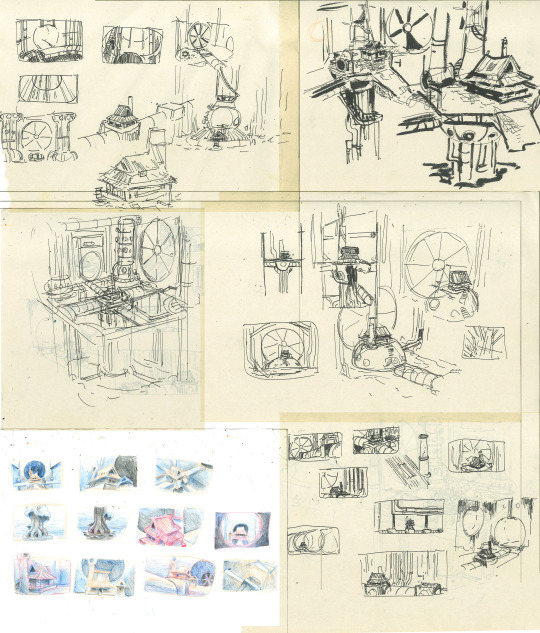


My first sketches (not shown here) were way too focused on details, and mysupervisor brought me back to the essentials : getting a strongsilouhette, making a clear statement. The key word being : concept. Myidea was an underground forgotten temple, trapped within a huge structure, akinto huge sewers mixed with industrial elements. The goal was then to design theplace like i would with a character : trying to find a good shape andsilouhette, a clear one, that quickly translate your idea to the viewer. Atthis point there is a lot of brainstorming to do, and refining your concept byasking yourself a lot of questions :
-How did this place came to life ?–Who lives there ? –What kind of time period is it ?
2.3D model
Once i had made enough research to figureout the global design of the scene, i made a 3d model in google sketchup. Ithelped me to figure out the global proportions of the place and have a betterunderstanding of its volume. This is a free and very simple software that irecommend a lot ! The other great advantage of 3d in this case is that youcan place your camera anywhere you’d like and generate a simple linework out ofit. This method is used in production work because it allows layout andbackground artists to start with a good volume and perspective basis. Fromthere, they’ll use a design reference and complete the linework.
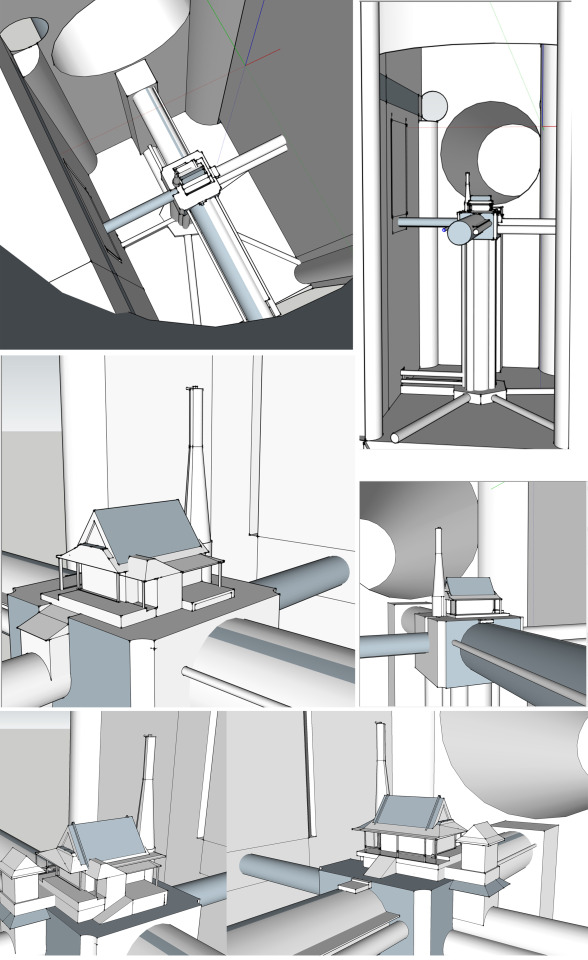
3.Roughing things out

After choosing an interesting view of thetemple, i started to add the main structural elements. It was a process ofgoing back and forth with my supervisor who provided a lot of advices andcorrections that i applied the best i could to the design. Going through manyiterations, the temple started to take form. One of the important task was toadd details without loosing the sense of structure and silhouette. It isimportant to establish good scale relationships between the elements in orderto keep it coherent.
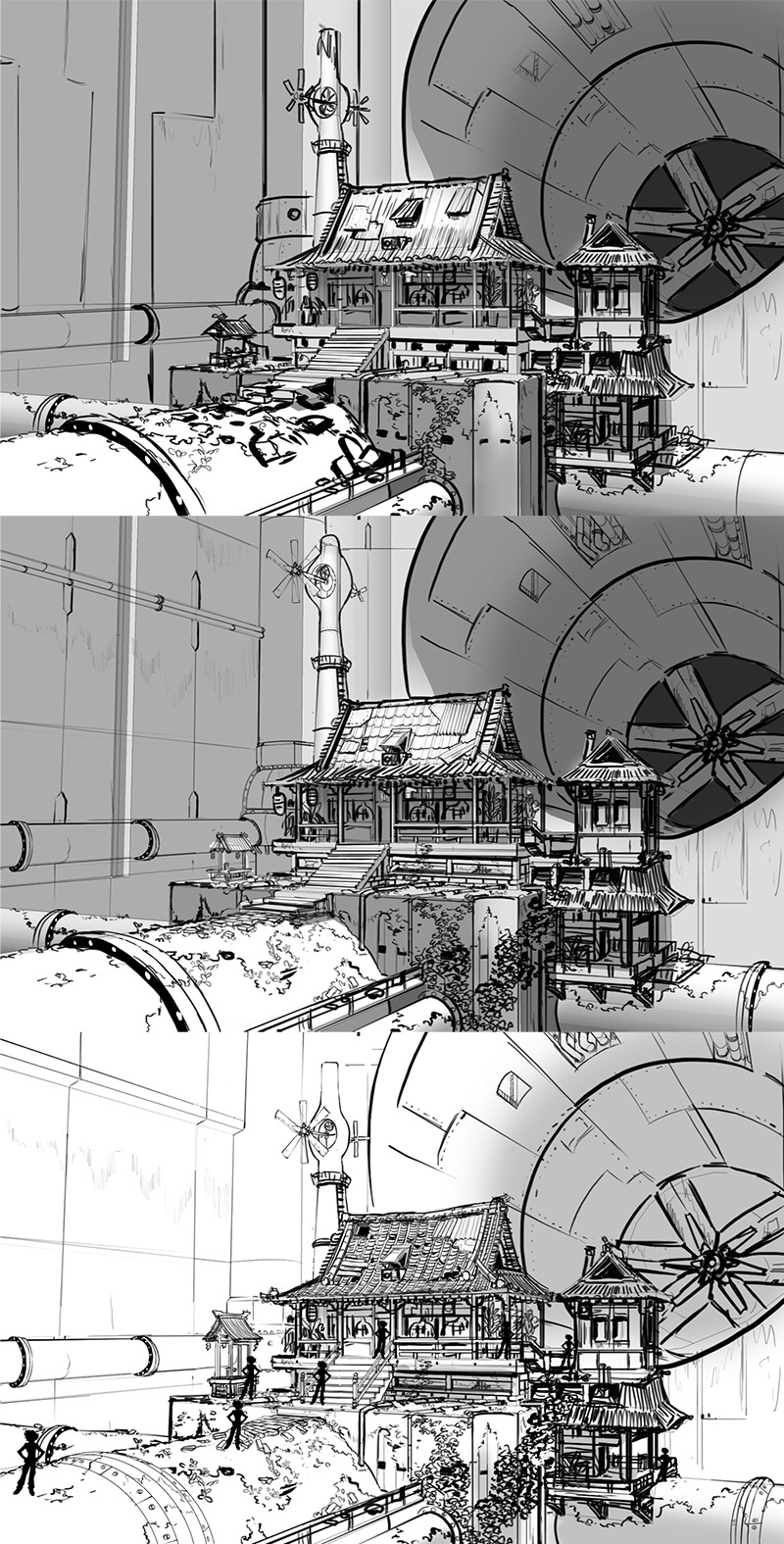
This brings me to the next point :
4.REFERENCES
This is probably one of the most criticalpoint of drawing in my opinion. Ourimagination is fairly grounded in reality. It is really hard for us to imaginesomething completely from scratch, especially in the fields of drawing andcreative work. If you want to draw something which is believable, be it acharacter or background, you’ll need to understand it well. The references thencome into play. Internet gives the artists of today a tremendous amount ofinformations and photographies about a huge range of topics, that artists fromthe past couldn’t even dream of, and it would be a waste not to take advantageof it !
In my opinion, understanding is key, andmore important than copying. While using references, a good thing is to analysewhat you are seeing, deconstruct the information in order to re-use it at wishwhen you need it.
Here are just some examples of references ipicked up for this design :


The sewers of Tokyo : This was a hugediscovery for me ! I had no idea that this kind of structure existed and iwas amazed by its sheer gigantism ! And it also was a perfect fit to whatkind of ambiance i was looking for!

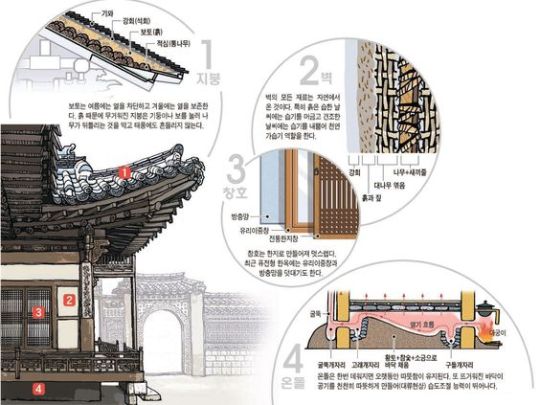


A LOT of temple, shrines and eastern asia architecturereferences ! I needed to know and understand what i was seeing, how thoseroofs would assemble, what shape would the pillars be, what kind of materialsand details would compose this kind of architecture and so on…



Some industrial and mecanical references aswell for the pipes and ruins around !
5.Cleaning and coloring
While using references, i went on tocleaning. When designing a background, i don’t think you need to have a perfectlinework as long as everything reads well and clearly. At this stage it ismostly refining everything, adding details. A good thing is to have differentline thickness for the foreground and background, details and global shapes. Itbuilds hierarchy and make different planes differenciate better from eachother.

I added simple colors areas in order tomake the different elements of the design stand out. It doesn’t relate to thereal colors, they are merely informative.

Once i finished everything, i decided to bringit to life with color, and then compositing and 3d, but this would deserve a different thread !



6.Last words and ressources :
I hope you enjoyed this thread and that it’llbe of any help !
Go check the blogs of my supervisors andcolleagues during my internship, they do RAD backgrounds :
Vnzzz
Yann Legall
Thomas Romain and his perspective tipswich are a must-have ! They are very clear and useful !
Concerning resources, i would recommend (ifyou haven’t already) getting a pinterest account with loads of boards.
Also check https://www.textures.com it is basically aimed for 3d texturing, but there is a lot of variety in shapes and forms whichcan be useful when looking for references.
There also is THIS reddit called the « safefor work porn network » Despite its strange name, this reddit has thousands and thousandspictures about many different topics. You can spend hours gathering referencesthere.
As a conclusion, i would say go anddraw, draw a lot, and draw some more, keep practicing, analysing, referencing,designing and having fun !

Have a nice day !

#background#tutorial#ask#ressource#thread#design#background design#visual development#aimation#mric#art#artists on tumblr#development#temple#underground
766 notes
·
View notes
Text
Useful Tips For Successfully Cracking NEET 2019
It is that point of the year once more, once the tutorial world is captivated with the ‘NEET 2018’ development. everyone is busy gushing over their textbooks and guides, pertaining to notes, finding out into the night, and sitting at their table, consumption on pencils and making an attempt to hit the books all the formulae. You wouldn’t notice anyone chatting with their friends or watch television. Isn’t it nice to check everybody busy? At this significant time, it's necessary to possess some tips to crack NEET 2019.
With simply some months left for the examination, your preparation may well be fully swing, right? whereas there square measure students WHO have started their preparation, there are people who don’t skills to set up their NEET 2019. If you haven’t yet started, please offer yourself a well-mannered punch and begin making ready today! the foremost necessary step of all is that the commencement, guys. you'll set up the journey to the destination well as long as you recognize the start line.
If we tend to go together with the specialists and NEET toppers, dedicated follow and revision square measure the foremost factors that may result in success. If you're someone targeting the coming medical tests, undergo the following pointers to crack NEET 2019!
1. Recognize the program of the examination well
NEET program is as immense as associate ocean, and you wish to understand the precise location to fish the simplest output. hamper on additional info and specialize in necessary topics. Since we all know NEET communicating covers NCERT program likewise, you'll compare the program along with your Board communicating program. it's useful for you if there square measure common chapters as you may not ought to prepare them on an individual basis. this can offer you ample time to target the components of the program that aren't coated.
Important Focus Areas for NEET 2019 are:
Physics – Mechanics, Optics, physics and atomic physics Chemistry – Mole idea, General chemical science, tabular array, Chemical Bonding, Coordination Chemistry Biology- Ecology and setting, Genetics, Cell Biology; Morphology, copy and Physiology of Plants and Animals; Basics of Biotechnology
2. Smart study material
Yes, that’s the foremost necessary element! whereas choosing the proper study material for NEET is small confusing, with help} of lecturers and on-line skilled assistance, you'll opt for the proper one. you'll consult NEET toppers and see that book they referred. Of course, they won’t be accessible for all of you. So, you'll browse NEET topper interviews and take a look at to induce a concept regarding their preparation vogue. you must prepare study notes for NEET, solve previous years’ question papers and take mock tests to boost your speed and accuracy.
3. Come up with a good study plan
Time is invaluable. we tend to all recognize this, nevertheless several aspirants fail to form the right use of your time and take a plunge. Goal setting are often used as a method to assist aspirants bring positive changes into their lives. so as to implement the setting of a goal, check that to raise oneself some questions: what's my goal? Is my goal realistic? what proportion effort must be place in to satisfy my goal? till and unless you create an entire and thorough schedule of the means you would like to check, you may not be ready to complete the program. set up for the week prior to and puzzle out chapters that you simply ought to prepare from the start.
4. Work on weaker areas
It is potential that you simply square measure terribly sturdy in one subject and weak within the alternative. Don't get discouraged by a similar. attempt to work effortlessly a lot of on the weaker areas to strengthen them. If needed, take facilitate from a devotee or senior or take additional categories for the topic. it'll facilitate in overcoming the concern of your weakness effectively.
5. Follow mock take a look at papers
One of the best challenges of the NEET examination is that the time limitation. Students have to be compelled to end a hundred and eighty queries in a hundred and eighty minutes (3 hours). It means that they'll provides a most of one minute per question. Time management may be a obligatory ability that's needed for this communicating. whereas active reception, check that that you simply keep the time limitation in mind. see complete answer of NEET previous year question paper; specialize in the commonly asked queries, topics and pattern.
6. Regular study breaks
We square measure humans and not machines. So, we tend to need timely rest as, after all, even machines want some rest to induce back to operating with efficiency. Hence, it's essential to understand that one can’t maintain associate optimum level of concentration while not taking associate optimum break to recover. however watch out that you simply don’t bring the breaks on a better priority than studies. Breaks are often within the sort of a ten-minute walk, a visit to the athletic facility, having a talk with a devotee or just taking a little nap.
7. Use new technologies
There square measure many folks WHO study by light within the textbooks and creating notes with a pen on a scrap of paper. These strategies still notice their place and importance, however there square measure incalculable choices for personalizing study than ever before. Be it through on-line tools, social media, blogs, videos or mobile apps, learning has become straightforward, attention-grabbing and user-centered nowadays. If you would like to undertake a replacement learning technology, then Toppr may be a good spot to be told.
8. Don't fall for approximation
Many candidates have the tendency of taking the approximation route for determination queries they don’t recognize. However, it'd prove risky during this case as there's negative marking for a wrong answer. it's suggested to go away an issue utterly if you are doing not recognize the proper answer. this {can be} one in every of the foremost necessary tips to crack NEET 2018 that anyone can give!
9. Health is everything
It’s crucial to judge yourself each physically and mentally. rather than whining “I ne'er get enough sleep” or “I’m intake an excessive amount of food,” take hold and set up for transfer within the balance. this can assist you to be happier and a lot of productive. Avoid junk and oily foods and switch to healthy diet plans. Do meditation and yoga exercises for higher concentration. of these tips to crack NEET 2018 would be useless while not this one factor!
10. Quality is imperative
Your perspective decides the effectiveness of the training method. If you possess a negative approach and keep spoken communication that you simply can’t bang, then this won’t plan to the thought of learning. A grumbling approach can solely build things troublesome. the instant you begin thinking absolutely, your brain can show bigger activity. A right frame of mind conjointly causes you to feel less anxious and a lot of receptive new ideas.
I would like to tell another secret, which still most of your peers are not aware of. There is a new App that has come to the market, with a noble objective to help NEET Aspirants like you, for not only making you thorough in NEET syllabus, but also for making you competent among your peers. The App has mock NEET exams that are timed. These are called NEET Challenges. Here, you will not be just taking the mock NEET exams . You will be rather taking it as a challenge to gauge yourself among your Peers, saying, who is going to top NEET exam, you are me? Although the above mentioned information would help you crack NEET exam successfully. This NEET challenge App can make a strong NEET candidate, who can face the NEET challenge 2019 with complete confidence.
VICTO NEET Challenge App
Register with Victo NEET Challenge App and challenge your peers by taking Victo NEET Challenges. Get started with Victo NEET App by downloading Victo App from the play store at https://play.google.com/store/apps/details?id=io.victo.neet&hl=en_IN
I wish you All the Best for NEET 2019!!!
2 notes
·
View notes
Text
You Should Experience SEO 2019 At Least Once In Your Lifetime And Here's Why
SEO is about growing naturally, and also to develop a good effective, organic online marketing strategy, it's important to not just look at SEO, but content material marketing and social media, as well. Keep in mind that will links, content, and user encounter are all major SEO rating factors. Could holistic approach will ultimately eliminate a lot of the particular issues created by some SEARCH ENGINE OPTIMIZATION practitioners over the years, I actually suspect that search engines' designers will initially overestimate the accuracy of their AI, resulting within Penguin-level collateral damage. SEO (Search Motor Optimization) is the process associated with making a website more noticeable in search results, also called improving search rankings. Siteimprove SEO furthermore provides in-tool tips on where to start and the way to get the most out associated with your keyword research and supervising. We've already been operating in the SEO plus content marketing industry since last year and know how search motors work. Generally there are a great number associated with resources out there surrounding competing link analysis (and a great deal that have been authored simply by me! ) but whenever I actually speak with people that are usually working on SEO projects, really always one of those "yeah, I realize I should do this more" tasks. Amy Kilvington, Marketing Executive at Custom Drapes, believes that SEOs are heading to have to optimize social networking more as Google indexes this and prioritizes it over their particular sites' pages. Social media is definitely the easiest and most efficient way to push out the SEO-based content. However, presently there are some easy adjustments that will you can make to the particular search engine optimization (SEO) component of it, which will ideally provide you with fantastic results. This particular means that SEOs spend the lot of time working upon getting links in a procedure called link building Link-building techniques can range from simply asking for a link to writing the guest post - and presently there are many others. Basically, SEO plans the keywords that will are to be delivered plus content provides them. So, when you are considering about applying SEO in the particular broad sense, you need in order to channelize its technical specifications by means of content marketing. In 2019, you can wager that White Hat SEO can have separated itself even more from Black Hat SEO, plus that above all else, offering quality content will be the particular most important factor for companies ranking in search. The outcomes are not instant, you can use the time on attempting other Internet marketing techniques whilst SEO would go to function. The third major SEARCH ENGINE OPTIMIZATION ranking signal is Google's synthetic intelligence search ranking algorithm. Sometimes SEO is usually simply a matter of producing sure your site is organised in a way that lookup engines like google understand. SEARCH ENGINE OPTIMIZATION involves a number of modifications towards the HTML of person Web pages to obtain a higher search engine ranking. As a result associated with technological advancement, SEO is in order to undergo more drastic changes, plus the two latest technologies that will are expected to influence SEARCH ENGINE OPTIMIZATION to some very great level are AI (Artificial Intelligence) plus Voice Search. The traditional strategy to SEO has been devoted to creating excellent content that will is easily searchable via research engine bots. To realize SEO, you'll also need in order to know how Google search functions. 2019 can still use many of these kinds of newly implemented tactics, but research engine optimization experts are furthermore suggesting there will be a lot more. Currently more than half associated with searches account for mobile products, and the number will definitely move up in 2019. Within the remaining 2018 quarter, a person need to invest in mobile-first content that will rank a person higher in mobile search within 2019. The vast majority of your SEO learning need to come from online resources, yet there are a few publications that will help you conceptually understand the history of lookup, search engines, and how SEARCH ENGINE OPTIMIZATION has changed through the many years. There are several methods that webmasters use within order to entice potential clients to their site—one of the particular most important and effective associated with those being Seo (SEO). SEO is important for a lot of companies because if individuals find you with a web research and find what they're searching for, you can receive plenty of new web visitors that will can help you earn even more money. Good SEO follows guidelines that Search engines determines are best practices in order to have your articles ranked upon top. SEARCH ENGINE OPTIMIZATION services do thorough keyword analysis for any specific website, and after that optimize the information on the particular basis of these keywords plus theme of website.
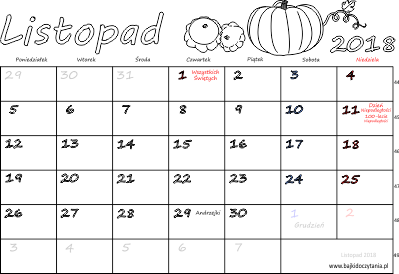
Based on SEO software program company Moz's bi-yearly survey upon search engine ranking factors, the particular titles on your page are usually one of the nine nearly all important considerations a search motor makes. Having an SEO technique that effectively promotes your picture taking business, driving new traffic in addition to taking into consideration the requirements of the site visitors even though you concentrate on perfecting the art is a really strong tool. SEO is Lookup Engine Optimization and it is definitely required for make a internet site view-able. And you may see the section on exactly where to use keywords for even more information on integrating these key phrases into your SEO content technique. 22. Use social media in order to boost local SEO. SEO is the acronym for Seo. Even though certain techniques of SEO content material Blog9T remain the same, like not really compromising on quality; there are usually definitely techniques which have advanced from the past and a person should find out whether your own SEO articles writing services are usually very well aware of that will or not. SEO service companies are specialized in increasing the particular traffic to your site simply by increasing your position in the particular search engine ranking positions. Bring in international people to your internet sites with these SEO tips. The top challenges within organic SEO are link creating (easy-to-get links no more possess much value) and keyword study (the low-hanging fruit is lengthy gone). For instance, the phrase ‘SEO tips' is furthermore included inside the less competing phrase ‘SEO tips 2019', which usually is searched for too. Several search engines have also supplied to the SEO industry, plus are frequent sponsors and visitors at SEO conferences, webchats, plus seminars. If a person have a website that a person want to become easily discovered by a search engine, you have to increase your site rank by means of SEO as well. Some SEARCH ENGINE OPTIMIZATION companies focus on link building” and increasing the authority associated with their clients' websites. Through an SEO perspective, we had been introduced to RankBrain nearly 2 years ago, a machine-learning synthetic intelligence that Google's been making use of to process an extremely huge proportion of search results. Specifically, you'll observe exactly how to make use of advanced on-page SEO strategies (like Bucket Brigades”) to get higher Google ranks and more organic traffic. Search engines has introduced (at least) the ‘percieved' risk to publishing a lot of lower-quality pages on your own site to in order in order to curb production of old-style SEARCH ENGINE OPTIMIZATION friendly content based on manipulating early search engine algorithms. Grey hat SEARCH ENGINE OPTIMIZATION is entirely centered on enhancing search engine rankings. There are several aspects to SEARCH ENGINE OPTIMIZATION, from the words on your own page to the way some other sites link to you upon the web. So, rather than viewing SEARCH ENGINE MARKETING as an umbrella term covering SEO, it's more accurate in order to view SEM (paid search) plus SEO (organic search) as independent entities to use as a part of your Search Marketing arsenal. If you work in lookup marketing, you'll know that SMX is one of the greatest search engine marketing conferences associated with the year, covering topics which includes SEO and PPC. SEO is conducted each on-site and off-site via various resources that are the existence of your web identity associated with different social media platform plus prominent display of your home page's link on other well-reputed internet sites. Our unique data science-driven SEO & content marketing platform can help your eCommerce business reveal millions of dollars' worth of earlier untapped organic search marketing possibilities. On the other hands, if the website doesn't make use of any digital marketing strategies or even SEO services, no one troubles to search for pages plus pages on Google just in order to find your website and check out it. Some dentists, who possess tried applying SEO, have not really been very successful in moving their website to the best of Google search engine. Just before we do, let's check away a couple essential areas regarding SEO: social media and cellular. SEO can price between $100 and $500 for each month if you do this yourself with a keyword analysis tool. This SEO guidebook explains acquiring links from exterior domains. Let's review the fundamentals of SEO (search engine optimization). SEARCH ENGINE OPTIMIZATION is conducted on the knowning that webpages rank because associated with how relevant a webpage is definitely to a search query plus how many links point in order to that webpage. Business professionals try to rely on these SEO techniques with regard to optimization wishing for a larger profit. The Latent Semantic Indexing (LSI) Keyword Electrical generator is like a thesaurus with regard to SEO -minded content marketers. SEMRush - Another excellent tool for SEO analysis, especially where it concerns business cleverness, SEMRush allows you to recognize and analyze the keywords that will your competitors are using. I'm heading to share some of our most effective SEO tips that will I've used within all types of campaigns to increase organic lookup traffic. FAST SEO ADVICE search engine search engine optimization is not magic, and are not able to perform wonders. This SEO ideas and tricks cover all the required information you should know with regards to Search Engine Optimization. The SEO content author should have a strong knowing of the keywords that are usually ranking and trending on the particular analytics framework. In 2018, there were certain trends that will ruled the world of online business SEO (search engine optimization). Don't get worried by them but make certain to use only natural hyperlinks and keep in mind that will their SEO potential may end up being a bit lower in evaluation with single links. As a partner to the table, Internet lookup engine Land's Guide To SEARCH ENGINE OPTIMIZATION explains the ranking factors within more depth, in the tutorial supplying tips and advice on applying them. Google states that cultural media is not an fast SEO ranking factor, but many experts agree that things this kind of as retweets and facebook stocks DO, in fact, effect websites' rankings. And since SEO furthermore targets users who are positively searching for products and providers like yours, the traffic ensuing from SEO is more certified than many other marketing techniques, leading to cost-savings for businesses.

An extensive dental marketing plus dental SEO campaign can become attained by the enterprise just if the web address associated with a dental practice contains in to all the promotional materials intended for the business. This shows the importance of focussing voice search engine results within order to grow your company, marketing, and Search Engine Optimization(SEO) strategies. They obtain this by increasing their internet site rank through a method known as SEO or even search engine optimization. Just like most other SEO approaches, be certain your links are appropriate, plus be careful never to cross the particular line into excessive linking : you don't want your site visitors to obtain annoyed. Bryan Yeager, Research Director at Gartner, can share 9 Key Insights through Gartner's Marketing Technology Survey in order to Help You Prepare for 2019 and Beyond. SEO is a combination associated with digital marketing efforts all functioning together to increase a web site's value to users and presence in search. On-page SEO (also identified as "on-site" SEO) will be the work of optimizing different parts associated with your site that affect your own search engine rankings. In 2019, we will have to optimize voice research answers with CTAs that Google's algorithms don't pick up upon, but humans do. Dan Mallette, Lead SEO Strategist at each InVue Digital & HearstDMS, forecasts that SEOs will need in order to optimize for voice search and locate new avenues as SERP real-estate shrinks. Obviously, a social networking site that has more interaction will bring bigger SEO benefits for you to some business than one the fact that has less interaction, but only having a social presence is definitely a good start. Search engine optimisation (SEO) may be the process of impacting the online visibility of the particular website or a web web page in a web search motor 's unpaid results—often known because "natural", " organic ", or even "earned" results. Seo (SEO) is a procedure of improving positions in natural (non-paid) search results searching motors. Various other SEO ranking factors include: available URLs, domain age (older will be usually better), page speed, cellular friendliness, business information, and specialized SEO. Your own search engine optimization strategy can become divided into two different groups: on-page SEO and off-page SEARCH ENGINE OPTIMIZATION. When you familiarize yourself with this local community, you will inevitably stumble your own way onto the websites associated with SEO Gurus” selling courses that will teach you SEO for hundreds of dollars. Expert SEO writers can also make use of modifiers and keyword variations in order to further optimize the content. In the 10 Moments To Remember From SEO 2019 lot associated with cases, this happens as the consequence of non-ethical SEO specifically buying and selling links which usually could get you up the particular Google ‘adder' quickly. Content will be key but content alone will be no longer king; content, circumstance, and relevance will drive functionality of content and digital marketing and advertising, and SEO is part yet not full parcel. Ultimate WordPress SEARCH ENGINE OPTIMIZATION Guide for Beginners (Step simply by Step) — 28% of internet sites on the internet use Wp. SEO is usually abused as a blanket term intended for digital marketing. Link building is a type of off-site SEO where additional sites link back to your own site if they feel a person offer something of value in order to their audience. In many essential areas they overlap; if SEARCH ENGINE OPTIMIZATION is more technical and provides to a narrow sphere, articles marketing takes a holistic technique. Equally, generally there is no point in losing your SEO marketing efforts simply by delivering lots of traffic in order to your website from highly related search queries, when the consumer experience upon landing on that will website is poor quality. On web page, SEO relates to keywords. In addition to the over search engine optimization solutions, SEARCH ENGINE OPTIMIZATION services provide other Internet advertising services, which includes: search-friendly internet design, pay-per-click (PPC) advertising promotions, backlink programs, SMO services, blog site optimization and marketing, targeted regional search engine marketing, and cellular marketing optimization. A successful SEO effort requires to move beyond building delighted to rank on highly researched keywords and should have the heavy focus on providing solutions for genres of unique questions that many people might research by voice. Learn the particular strategy behind great SEO, which includes keyword planning, content optimization, hyperlink building, and SEO for e-commerce, local search, and mobile viewers. Seo or SEO will be the simple process of making sure a website can be discovered in search engines for words and phrases and phrases relevant to exactly what the site is providing. Performing SEO upon your own websites is the great method to practice plus hone your SEO ability. We optimize your web site both of internal and exterior factors thats Google's engine believe in and reliable for top rank search result, Gurantee your SEARCH ENGINE OPTIMIZATION ranking No succeed can refundable. Looking deeper: An SEARCH ENGINE OPTIMIZATION cost often means one associated with two things: the investment within your organic search strategy, or exactly how much you pay for compensated search engine marketing (SEM) solutions like Google AdWords. All of us are dealing with new methods designed to target old design SEO tactics and that concentrate around the truism that WEBSITE ‘REPUTATION' plus Plenty of WEBPAGES plus SEO equals Plenty associated with Keywords equals LOTS of Search engines traffic. BrightonSEO is a one-day search advertising conference and series of education courses held, unsurprisingly, in Brighton. From narrowing lower target markets to changing the particular way content is written, AI and voice search will possess a continuous effect on SEARCH ENGINE OPTIMIZATION moving forward. One aspect of SEO is usually link building, which we will certainly discuss slightly below, which generally leads to thin content. Applications for this 2018-2019 cycle of the SEO Progress programme are now closed in addition to will re-open again in Early spring 2019. SEO could be complex because search engines are often reevaluating and changing how they will prioritize search engine results. Moreover, it will help SEARCH ENGINE OPTIMIZATION by gaining backlinks, likes, remarks or shares. You may generally see outcomes of SEARCH ENGINE OPTIMIZATION efforts once the webpage proceeds to be crawled and listed by a internet search motor. Possibly the best form of sociable media to pay attention in order to when turning to SEO is definitely Google Plus. A single of the most successful methods to ensure your clients discover your photography business is simply by implementing an SEO strategy, this particular is more than just generating it to number 1 about Google, it means ensuring the fact that a varied and steady flow of traffic is heading to your site, over plus above that of your rivals. If you are usually willing to improvise your site search and boost up your own Google ranking, but do not really have time or resources intended for doing that, hire an SEARCH ENGINE OPTIMIZATION specialist for the same objective. Mobile SEO will be mobile search engine optimization or even optimizing content for a much better search ranking. Titles on pages and explanations affect what people see within search results, so it's important to check these out within any SEO audit. Search motors give some guidelines for SEARCH ENGINE OPTIMIZATION, but big search engines maintain result ranking as a industry secret. Along with $80 billion forecast to turn out to be spent annually on SEO — and content marketing set to be able to be considered a $300+ billion industry by means of 2019 — it might end up being tempting for stakeholders to notice SEO and content marketing while cost centers rather than income centers. While that will theory is sound (when concentrated on a single page, when the particular intent is to deliver power content to a Google user) using old school SEO strategies on especially a large web site spread out across many web pages seems to amplify site high quality problems, after recent algorithm adjustments, and so this type associated with optimisation without keeping track associated with overall site quality is self-defeating in the long run.

We all wished to look at a massive group that included businesses of most sizes and in all industrial sectors so we could really notice how SEO traffic increased whenever the only common denominator was including reviews to their site. In reality, this is area of the SEO technique we have used to continuously grow our organic traffic throughout the last 12 months right here at SnapApp: #3. Mobile will certainly account for 72% of ALL OF US digital ad spend by 2019. This workshop is usually designed to help business proprietors implement Digital Marketing techniques regarding their business including social mass media, organic SEO as well because paid channels. The Beginner's Guide in order to SEO continues to be study over 3 million times plus offers comprehensive information you require to get on the road to professional quality Search Motor Optimization, or SEO. Whether it's using web analytics for carrying out research or even conversion tools that monitor plus report the usage of essential keywords, SEO agencies know exactly how and where you can obtain the information they need in order to save time furthermore decrease your in-house price. Generally there is probably no more simple strategy for SEO than the particular integration of internal links in to your site - it is usually an easy way to enhance traffic to individual pages, SEARCH ENGINE OPTIMIZATION Consult says. SEO SERVICES Presently there are a number of SEARCH ENGINE OPTIMIZATION services which can help enhance the organic search engine ratings of a website.

You will end up being introduced to the foundational components of how search engines such as google work, how the SEARCH ENGINE OPTIMIZATION landscape is promoting and exactly what you can expect in the particular future. The SISTRIX Toolbox consists associated with six modules 1) SEO, 2) Universal, 3) Links, 4) Advertisements, 5) Social and 6) Optimizer. Low-quality content can severely impact the achievements of SEO, within 2018. When your own SEO starts building strong coffee grounds, competitors can start maligning your own SEO backlinks. ” With content marketing spend anticipated to reach $300 billion by 2019, this statistic is worrisome. Now the electronic marketing companies know how in order to use AI for SEO, plus in coming years AI can dominate in developing the SEARCH ENGINE OPTIMIZATION strategies of the digital marketing and advertising companies. Ray Cheselka, AdWords and SEARCH ENGINE OPTIMIZATION Manager at webFEAT Complete, the design and SEO agency, states that in 2019 search intention will continue to become even more important. Expert writers of SEO articles may take the time to study the particular industry or market market. 2 tools to help with nearby SEO are BrightLocal (for rankings) and MozLocal (for local research optimization). Concerning on-page SEO best practices, I usually link out to other quality related pages on other websites exactly where possible and where a individual would find it valuable. It includes a well known Regular Table of SEO Success Factors”, a 9-chapter guide to SEARCH ENGINE OPTIMIZATION basics, and links to several from the site's most useful blog posts.

Keyword studies about getting those terms so that a person can use them properly within content optimization and SEO within general. Just as content on your own isn't enough to guarantee SEARCH ENGINE OPTIMIZATION success, SEO alone isn't more than enough to ensure that people will certainly find and engage with your own articles. While intense SEO may involve complex site restructuring along with a firm (or consultant) that will specializes in this area, presently there are a few simple ways you can take yourself in order to raise your search engine ranking. Because we prepare to enter 2019, keyword creation for SEO professionals will become less important. Obtain the training you need in order to stay ahead with expert-led classes on Seo (SEO). Learn how to create articles, learn how to create some simple HTML, and the particular learn the very basic concepts of SEO, and you may make money online using SEARCH ENGINE OPTIMIZATION and article marketing to obtain your webpage (you only require one from each website) shown on Page #1 of Search engines (forget Yahoo as well because the rest) and you may get loads of visitors that will web page. If your website will be made up of lower-quality threshold type pages using old SEO-techniques (which more and more branded as spam in 2018) after that Google will not index most of the pages as nicely as your website ‘quality score' is probably likely to become negatively impacted. This particular is beyond website content, but great user experience has become a lot more and more important in solid SEO rankings.
1 note
·
View note
Text
Orphan Black season four full review
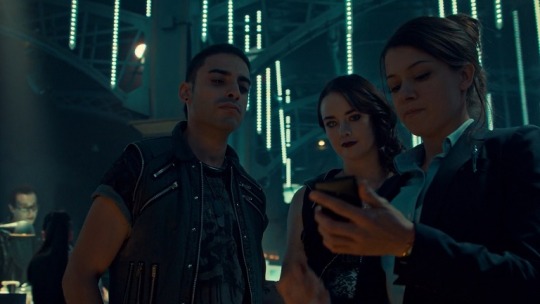
How many episodes pass the Bechdel test?
100% (ten of ten).
What is the average percentage per episode of female characters with names and lines?
59%
How many episodes have a cast that is at least 40% female?
All ten have over 50% female casts.
How many episodes have a cast that is less than 20% female?
Zero, obviously.
How many female characters (with names and lines) are there?
Thirty. Nineteen who appear in more than one episode, twelve who appear in at least half the episodes, and two who appear in every episode.
How many male characters (with names and lines) are there?
Twenty-three. Fourteen who appear in more than one episode, seven who appear in at least half the episodes, and zero who appear in every episode.
Positive Content Status:
Nothing particularly awful for once, but nothing very exciting either (average rating of three).
General Season Quality:
An absolute chore to get through. This show has run out all its goodwill and the illusion that it is about anything more than overwrought plot drama just for the sake of it has been dispelled. The show has always given the impression of believing itself to be more intelligent and complex than it actually is, but it seems to have finally reached an insufferable fever pitch.
MORE INFO (and potential spoilers) under the cut:
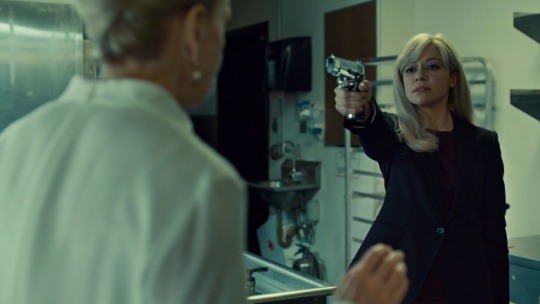
I’ve said it before for various different shows and for various different reasons, but this, my friends, this is why we evaluate content instead of just writing up statistics. This season churned out not just female-led episodes, but a fully female-dominant piece from end to end, easily the most female-heavy season of tv we’ve had on this blog to date. But that does not fucking make it good television, not entertainment-wise, nor from a representation perspective. To clarify: I’m not suggesting that the increase in female presence is in any way responsible for the drop in entertainment quality, I believe the two are mutually exclusive. Representation-wise, the numbers are relevant insofar as I have definitely seen people try to claim feminist triumphs before on the grounds of ‘there’s a lot of women there’, and realistically we all know you’ve gotta ask for more than that. Being present at the table is only the beginning of the battle: if you are relegated to the end of the table, not given anything to eat (or not fed the same as the other dinner guests), not allowed to speak, or not listened to when you do speak, then your issues persist. Being expected to smile politely and just be glad you were invited at all is not how positive representation works. Orphan Black did not commit a litany of feminists sins this season, but neither did the abundance of women on deck achieve anything on a representational front, and I will not praise it for sheer numbers when it isn’t doing anything good with them.
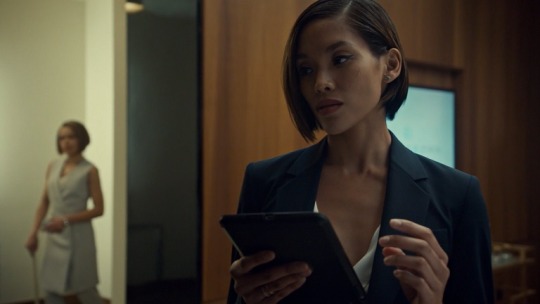
This seems a necessary time to talk about differing standards of expectation in media, and specifically the rigorous demands placed on female-led stories to be ‘perfect’ or otherwise be derided as ‘proof’ that female-led stories ‘don’t work’. Society likes to use individual films/books/tv shows as stand-ins for all the media of like type that could ever exist - think of the endless supply of recent male-led superhero films, some of them excellent, some of them garbage, some of them wildly successful, some of them total bombs, and yet the spectrum of different qualities and receptions never colours the way people perceive the genre as a whole. Enter Wonder Woman, the first female-led superhero film of the current era, and the colossal make-or-break expectations for it as a movie, and for its female director, Patty Jenkins. All eyes were on Jenkins to prove that women could direct big blockbuster action movies - not to prove that SHE could do it, but that WOMEN could - and by the same token, the fate of any future female-led superhero films hung on the success or failure of that one movie. Now, in tv terms, Orphan Black was certainly not standing alone as THE representative for female-led television series, but as part of a minority movement it was and is still subject to the rigours of expectation; that it be good enough, successful enough to bring about more female-led shows in the future, that it convinces the Powers That Be that they can bank on female-led stories. The irony of raising expectations in order to demand the best is that of course, it stacks the deck. Women having to achieve twice as much as men in order to be considered just equal is part of why feminism exists. I bring all of this up because I am very wary of falling into this trap myself, and I need you all to know that when I judge Orphan Black for its lacking quality, it’s with full awareness of the potential double-standard, and not actually motivated by a frustration with the show for ‘letting women down’.
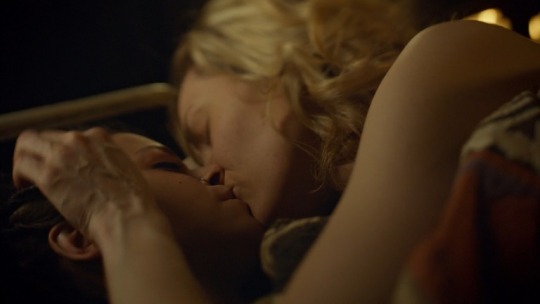
In last season’s review, I talked about jumping the shark, and I said then that I didn’t feel like Orphan Black had made that leap just yet. After this season, I’m reconsidering that assessment retroactively, and it’s because of Beth Childs. The premiere of this season was easily the strongest episode - arguably, the only strong episode - but it also kinda broke the show for me by revealing the fatal flaw: that they began the entire series by sailing over a rapid succession of Goddamn sharks. One ridiculously improbable event to kick off the whole narrative could easily be shrugged off and forgiven - many shows require such a conceit to get going - and Orphan Black got away with it at first by wrapping all its improbabilities into one package: Sarah Manning. The first and largest conceit is that Sarah just-so-happens to not only be present for Beth’s suicide, but that she has the opportunity to look Beth directly in the face and realise that they’re identical right before Beth face-plants a train. BUT THEN, Sarah takes Beth’s bag with all her ID, which Beth has conveniently set aside, allowing her to infiltrate Beth’s whole life. AND THEN it turns out that Sarah happens to be a gifted con artist of trained-spy proportions, both willing and capable enough to shrug on Beth’s identity based solely on the content of some home videos and a wardrobe change. Conveniently, Sarah is able to learn Beth’s mannerisms and accent well enough to approximate her successfully in front of her intimate partners and professional colleagues of multiple years, and she’s physically identical in weight and muscle distribution despite leading a distinctly less athletic lifestyle. I flagged all of these things back when they happened, but the show got away with them at the time because, after all, Sarah’s hustle is the entry-point into the series, so we go with the idea that we need to make that logical concession, just buy the bit, and we’ll get our entertainment in return. Problem is, season four goes and opens with a flashback episode to the time while Beth was still alive, and that busts the whole concession myth wide open.
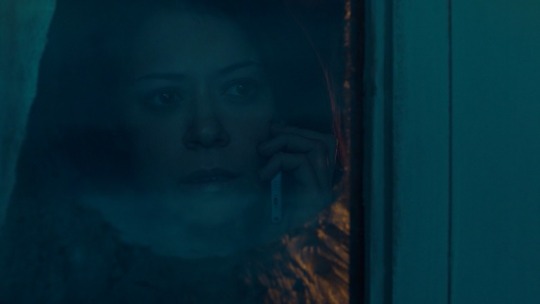
For starters, the plot is already in motion before Sarah shows up. We do realise that back in season one as Sarah negotiates her way around the mess she’s gotten into, but again, we run with the idea that we needed Sarah’s entry to make the whole thing work. The flashback episode shows us how completely false that is - Beth has an entire web of intrigue that we could have been watching instead, and if we’d started the show with her it would have been less jumbled and filled with needless drama than the premiere with Sarah. Imagine if the show started with, say, Beth being contacted by MK for the first time. She spends the premiere fielding tips from this new anonymous source, investigating something whack and presumably Neolution-related, and by episode’s end she forces a meeting with her source only to discover that they’re genetically identical. Cue show. It’s clearer and cleaner than all the futzing around with Sarah taking over someone’s life and faking her own death and having family drama and Vic drama and then having a German shot in her car and not getting around to the actual clone-reveal until three episodes in, and it allows the narrative to build from a logical entry-point instead of dropping into the middle and having to field all sorts of technically irrelevant detail in order to sell the whole idea. The flashback episode gives us a vision of what could have been a far better, more focused, more atmospheric, and more character-driven narrative, still full of drama, but LOGICAL drama, the drama of unfolding a conspiracy and trying to work out what’s real in the clones’ lives, the drama of all of them getting to know each other and adjusting to the revelation of their identity, etc, etc.
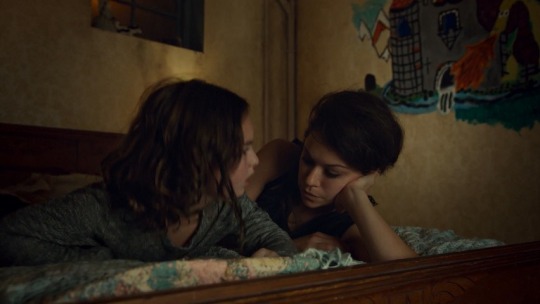
I have railed often and increasingly at how Sarah creates outrageous and unnecessary drama and often complicates the story instead of helping to drive through it, and it’s such a big part of why the show is swallowing itself slowly: it’s so busy being melodramatic for the sake of it and revolving around a reactive character who generates more trouble than she solves, and that leaves us drowning in the middle of the whole thing when we should be headed for shore. The show doesn’t actually need Sarah, and revolving around her because she’s the one with the magical baby-making womb is kinda grotesque and harks back to the issue of representation, because if your show is about women not because they’re people but because they can (sometimes) birth babies, then you’re conforming to the age-old notion that while men can be anything and everything, women are only worth acknowledging if their biological functions are part of the story. I suspect I may have to discuss that particular issue in more detail once the series ends, so I won’t get into it further just now; the point is, Sarah is a needless complication who required extraordinary machinations in order to be part of the story in the first place, and that first act of shark-jumping set the stage for all the ridiculousness that has come since. The show stacked the deck against itself: it set a precedent of needless hyper-drama designed to make the plot look as twisty and crazy as possible, and it has focused primarily and increasingly on looping around itself with more and more excessive conspiracy and back-from-the-dead characters and medical marvels, as if the early narratives about what it means to be a clone (y’know, the stuff that was more centred on characters and their feelings and stuff? The good shit?) and how that situates you within the world and your sense of self was not good enough. I’m remembering with bitter fondness the season one finale, when it felt like the extravagances of the plot were brought together harmoniously into a thoughtful exploration of the clone situation. What a thing this show could have had if it cared more about having a heart than it does about ~shock twists~. Having had the bubble popped on just how pompously ludicrous it actually is, I don’t expect to ever return to those good times, but who knows? Maybe concluding the show will lead them to introspect and try to bring us home on something meaningful in season five. I have little faith in that, but I’m holding out a glimmer of hope, regardless.

2 notes
·
View notes
Text
Research: Draw Draw Draw Project.
Mike Parr Mark making artist
Parr's performances explore physical limits, memory and subjectivity. They often depict self mutilation or extreme physical feats.
Parr spent his childhood in rural Queensland, Australia. He was born with a deformed arm, and this physical feature is prominent within his art work.
Parr’s impression taking is a striking contrast, both emotionally and visually to his video/ installation work, composed of beautiful engravings featuring many different types of lines, using the mark making technique. Parr was fascinated with observation and the possibilities and responses of memory distortions.
Parr’s early work was designed to get a reaction from the audience, although he also focused on exploring issues of identity, memory and states of being. He particularly used his body as a performative tool, often using his prosthetic arm and testing his body’s physical limits through resistance challenges.
In the early 1980s he started a collection called “the self portrait project”, Parr’s self portrait studies first took the form of painstakingly hand drawn copies of performance photographs. Subsequent drawings acknowledge accidental blurs and smudges, with parr generating purposeful distortions through the introduction of a mirror and manipulating the grid.
Life after death collection, combines charcoal, pastel and acrylic on paper; it depicts the artist’s face over and over, in varying states of distortion, as though disappearing or disintegrating.
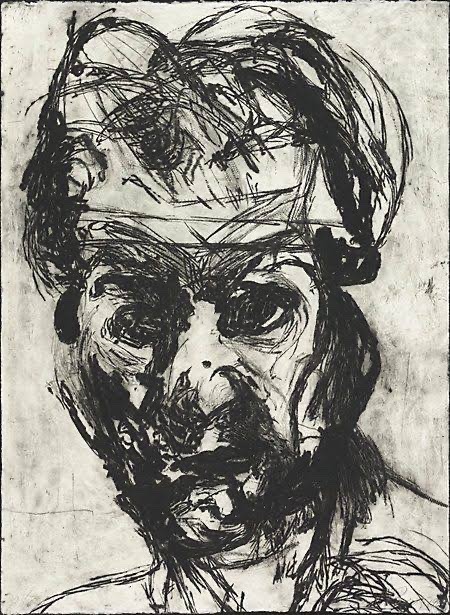


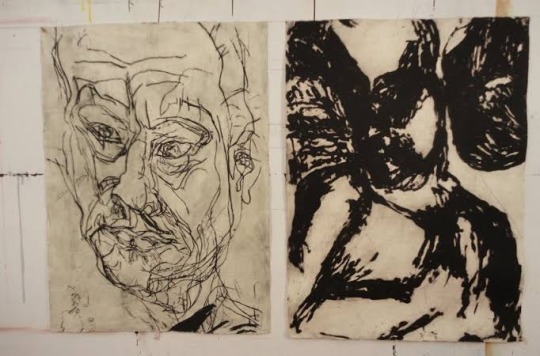
Paul Verdell
Is an American artist, who is specialized in drawing portraits of many different people that he can find as reference, by using different kinds of colors and lines with his crayons.
Verdell was born in Long Beach, California. At the age 13, his family moved to Fremont, Ohio.
Paul Verdell paints and draws a variety of people with plenty of personality. Like most artists, he has drawn since he was little, but didn’t make a real go of the medium until he was in his mid 20s. That he was decided to go back to school, enrolled in Bowling Green State university, and took a painting class when the first semester came around. Paul eventually developed his unique artistic style, by doing drawings, that him doesn’t consider that good, but he is comfortable with that style. His mark making technique is assertive, created with force and with energy. Paul’s work may seem as if it has loss control imbued within the lines, but his artworks are also vividly representative of the person or object he’s depicting; it’s delicate balance that he’s mastered without purposely pushing his style in a certain direction.
What I like most about his work, is his use of colors, with oil pastels , where he creates different tones on the skin of his characters, using the technique of mark making, which is perhaps more impressive, since it is a very different or unconventional technique for making portraits, that’s why it’s so interesting.
With time, he realized how much colour and expressiveness the textured medium adds to the canvas, and started to experimenting with more and more different types of colors.
The artist isn’t trying to make a statement with his work. In his words, “I’m just here to paint. The viewer can take whatever that want to take out of it”.
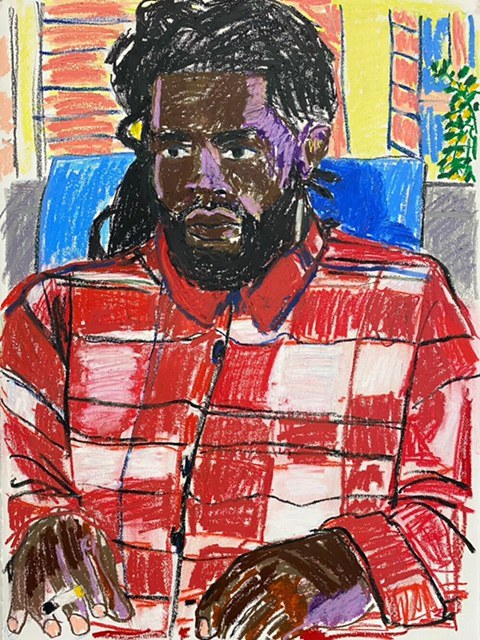
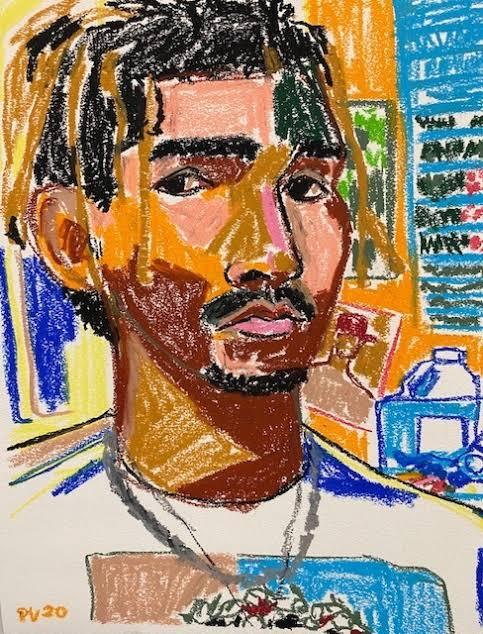
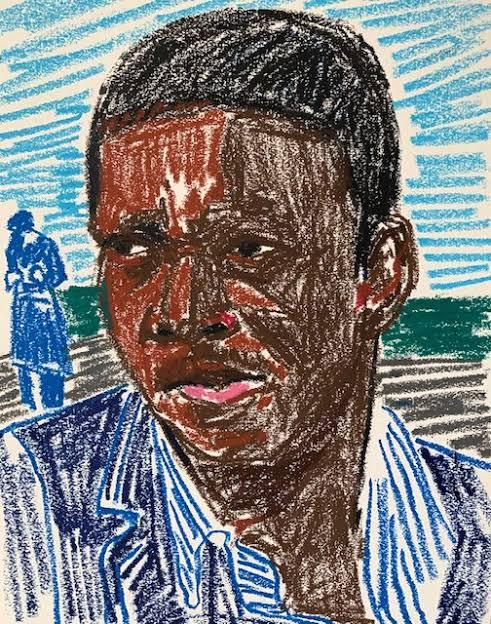
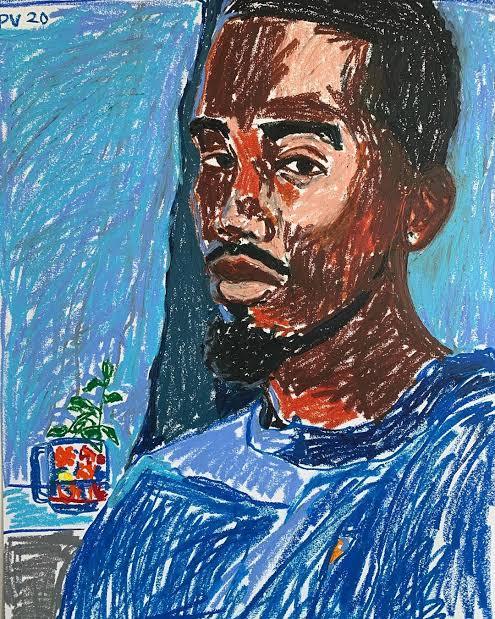
Saul Steinberg
Romanian artist by birth was one of the most important artists of 20th century. A designer and cartoonist in the publishing industry from 1936 to 1999, he spent a considerable part of the 20th century publishing in prominent magazines on the world stage, specially in the New York. The famous cover for the New Yorker that showed the view of the world according to the average American.
In his drawings, Steinberg’s lines seem to reinvent themselves as they progress, creating different kinds of shapes and sizes, sometimes using one single line.
Steinberg’s greatest contribution was his demonstration that the drawn lines is equivalent to thought. Indeed, Steinberg is rarely concerned with outward physical appearance and is much more interested in what and how people perceive what they see. His interest in the human psyche isn’t academic. His playful, childlike doodle quality maintains an elegant deftness that succinctly describes a wide range of subjects. His quirky way to draw, sometimes reminiscent of Dada art, also crossed over into the fine arts world.
much of the humor and mystery in his work occurs in the way he relates humanity’s lack of understanding.
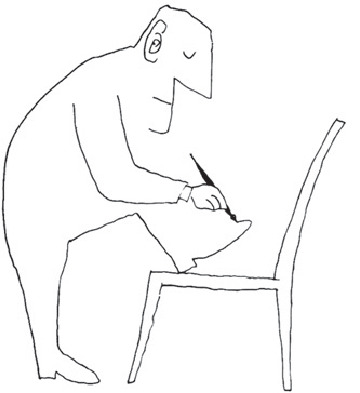
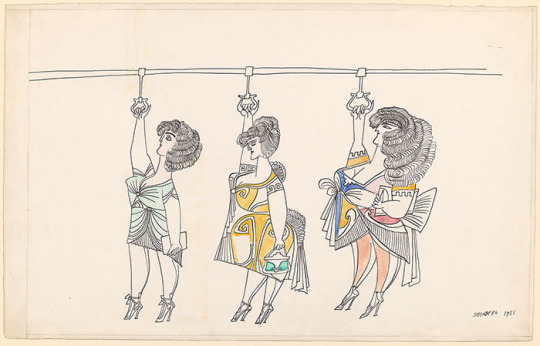
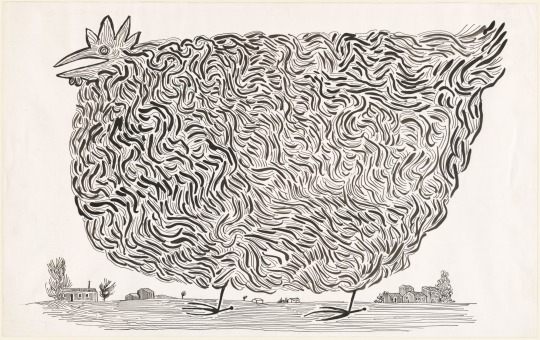
Urban Sketching
The drawings of urban spaces are gaining more and more admires, and this work certainly has a good baggage to please this audience, as it addresses a range of drawing techniques, which ranges from elementary theory to the more specific technique used by illustrators this modality.
Techniques and perspective tips combined with the composition tips presented in the work, are a combination that certainly makes all the difference when choosing and enhancing the scene that we will sketch, whether it be designing buildings, mansions, parks, people, animals, etc. the inclusion of the curved perspective is also another highlight, as it goes beyond the usual three vanishing points that the author usually address. The techniques, in this sense, are not many, but the author certainly selected those that generate the most impact. The watercolor for example, is his primarily tool, where he uses for the most of his drawings.
This book has been very useful for me for a long time, even today I use it as a reference. I always preferred to draw on my desk, with a reference photo. But I know that I need to let go, and learn to draw outside, just by watching, and trying to finish quickly.
I live in São Paulo for a while, and sometimes when I walk I always have a small sketchbook in my pocket and a watercolor kit. Sometimes I paint trees, sometimes buildings with interesting shapes and colors, from time to time some birds. Anyway, I learned a few things from this book, although I still prefer to draw in my studio, calm and do the drawing with all the time in the world, it is very important that I draw what is around me, so that I learn to train my eyes, in addition to drawing totally random things, which sometimes the internet cannot provide.
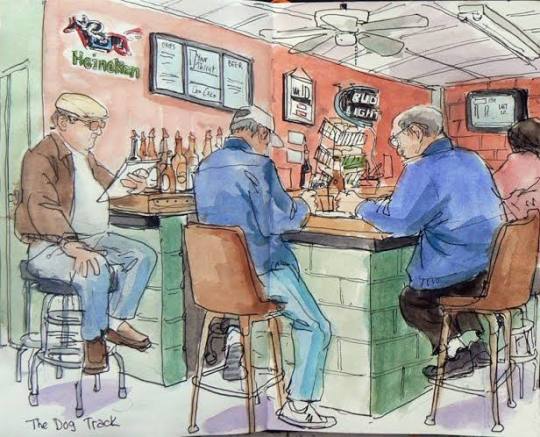
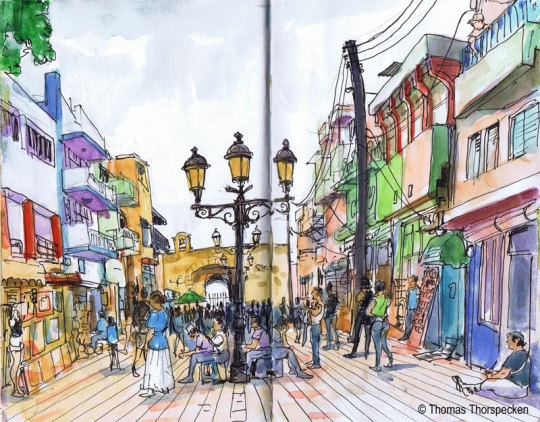
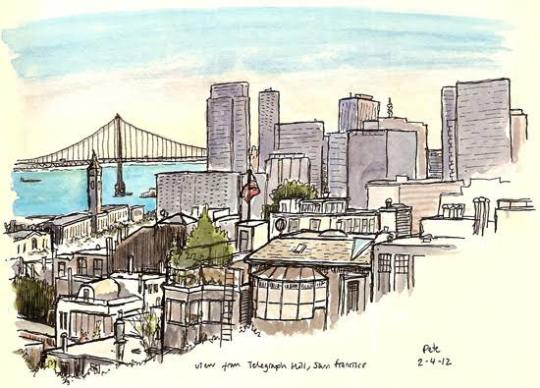
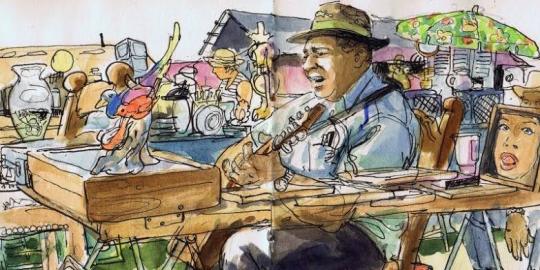
Alexander Calder Animal Sketching
Alexander Calder is a renowned sculptor and inventor of mobiles, and here he brings the simplicity of lines and spirit of movement to the art of animal sketching.
The purpose of the book is to help people like me to draw animals as we can see them.
Calder captures the emotions and attitudes of animals in a few quick lines, the person can quickly obtain a lasting groundwork in animal sketching.
This book really helped me, because I drew animal few times, and I was always thinking in the proportions and finalizing the drawing, but I learned that before doing that perfect drawing, I have to understand the movement and the poses, not necessarily making a masterpiece right in the begging, but train and have some fun on doing it.
This book contain several animal sketches, like cats, dogs, deers, cows, horses. All this animals doing different poses and actions for training.

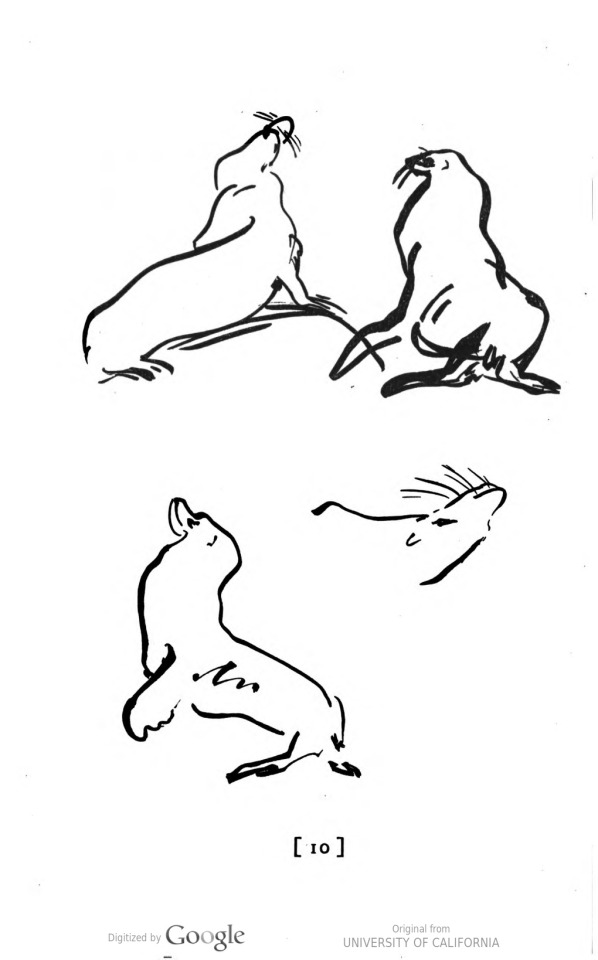
Juan Linares
Juan Linares is a Spanish illustrator and painter, who specializes in drawing mainly different environments (Urban sketching), from streets to buildings with a different style of architecture. He mainly understands the perspective and depth of the environment. Uses various types of materials, such as acrylic markers, even alcohol-based pens. But his preferred tool, of course, is watercolor, which he always uses, when walking in the streets of his city Barcelona, where he paints narrow streets, with the small bistros, from the famous La Sagrada Familia church made by Gaudi.
Linares says, that he’s been drawing professionally since 1984. Starting his architecture studies. He drew in sketchbooks, notebooks, and in blackboards. He has a preference in drawing food and buildings.
What I like about Linares's drawings, is the way he can put light and shadows, besides the buildings being magnificently well done, very carefully and calmly (he explains that if you are drawing in some environment it is good to be calm, and patience without feeling the need to finish quickly).
He has traveled to some places in the world, including Brazil itself, where he sketched the museum of Niterói, designed by the architect Oscar Niemeyer, besides the Christ the Redeemer in Rio de Janeiro.
Juan Linares is a great artist, and I really admire the passion he puts in each of his drawings. And I wish to see more of his works, of famous architectures of the world.
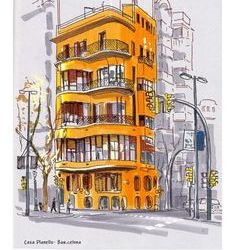



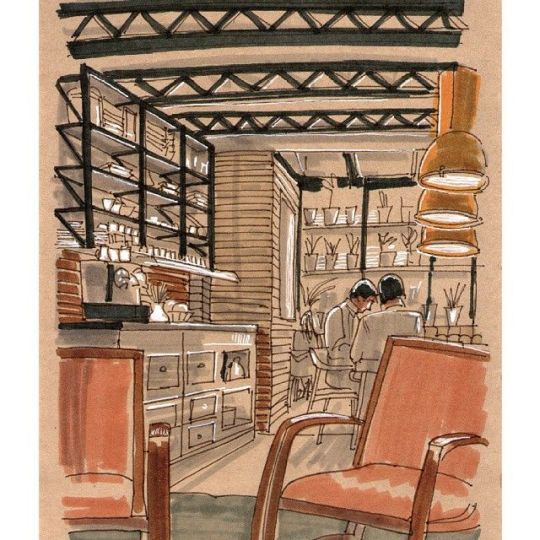
Laura Carlin
Laura Carlin was born is Glastonbury, England. She studied at Buckinghamshire university, followed by The Royal College of Art.
Laura has illustrated many children’s books for Walker Books Ltd, including The Iron Man by Ted Hughes which won many awards, specially praising for Laura’s illustrations.
She has also drawn for a whole host of publications including The New Yorker, The Guardian and Vogue, among many others.
Laura’s works frequently touches on emotionally complex subjects and adult themes of loss , social injustice and environmental change.
As an illustrator Carlin has worked with several contemporary children’s authors including Nicholas Davies for her book The Promise about a young thief whose life has changed after stealing a bag of acorns and Michael Morpurgo’s book The Kites are Flying ! , a story centered on the conflict between Israel and Palestine.
One of the reasons why, I like so much her work, it’s because she has the ability to convey a plethora of emotions through the smallest details on the pages, combining with childlike drawing style and with a sentimental narrative, it’s very brave of her, to do books for children, with such difficult themes to explore.
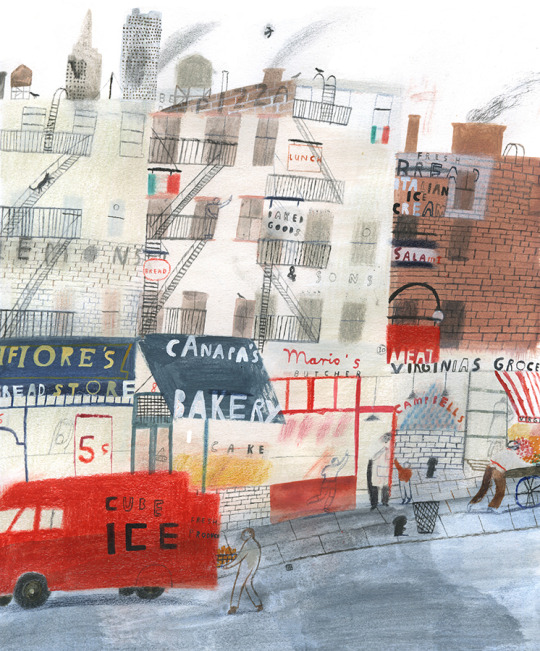
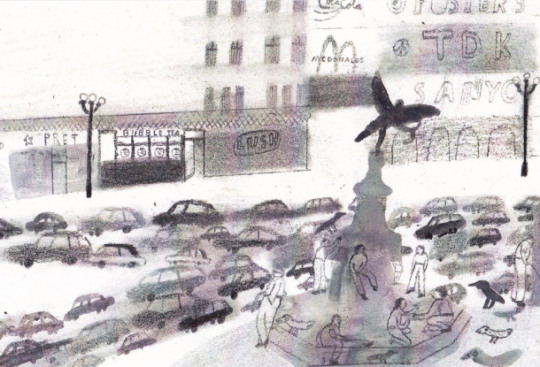
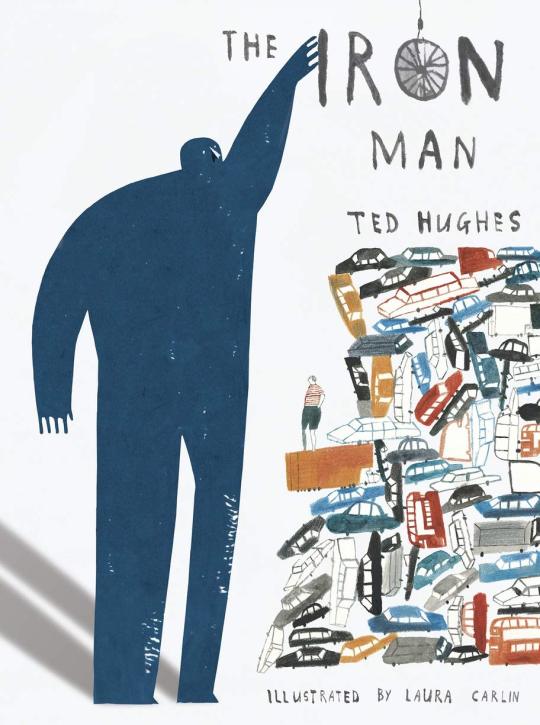

Research: Show and Tell Project
Frank Frazetta
Frank Frazetta was an American illustrator and painter, who became extremely well known for having defined the look, of the character Conan the Barbaro, created by Robert. E.Howard in the 1930s.
Frank was born in Brooklyn, New York, and from an early age he showed his skills as an artist. As a child, at the age of 8, he studied at a small art school called Brooklyn Academy of Fine Arts.
His illustrations are inspired by the great painters of the late 18th and 19th centuries, who portrayed mythological legends.
For me it’s not just the wonderful color palette he used, the wild and original streak or the phenomenal technique he developed. Of course, these things are fundamental, but in my understanding, the most important thing is that he defined practically everything we know in terms of visuals, mainly in the fields of fantasy, witchcraft, barbarism and even a little bit of science fiction.
His paintings defined some characters that we know today, like Tarzan and John carter, that he brought a new life to the characters of Burroughs, not to mention the images of Conan, who made the illustrator famous. Imagine that before him, the Sword and Sorcery look did not exist. The Conan that appeared on the covers of books since the 30s of the last century gets to laugh today. Frazetta was the first to understand the world created by Robert E. Howard.
The reason I chose frazetta as a reference is because I like fantastical worlds so much, and I love to learn anatomy, and frazzetta understood a lot of that, with his extremely vibrant colors, and extremely strong characters, who faced terrible monsters, who disturbed the peace.

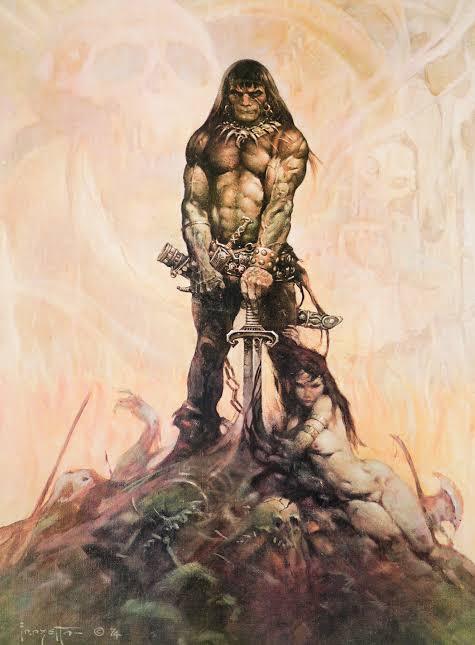
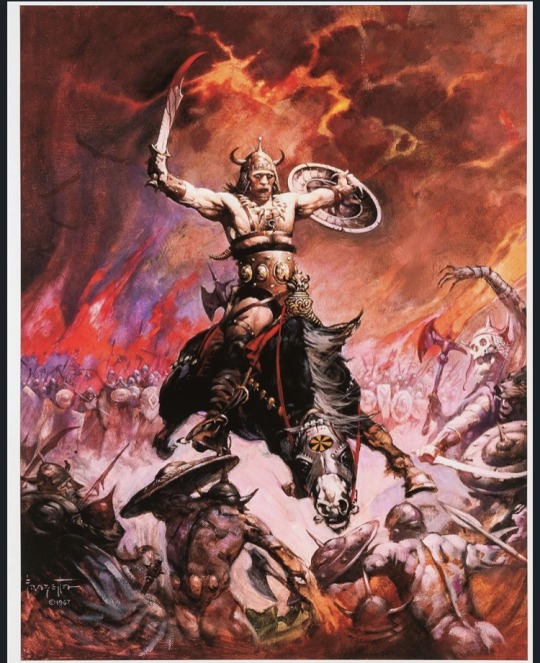

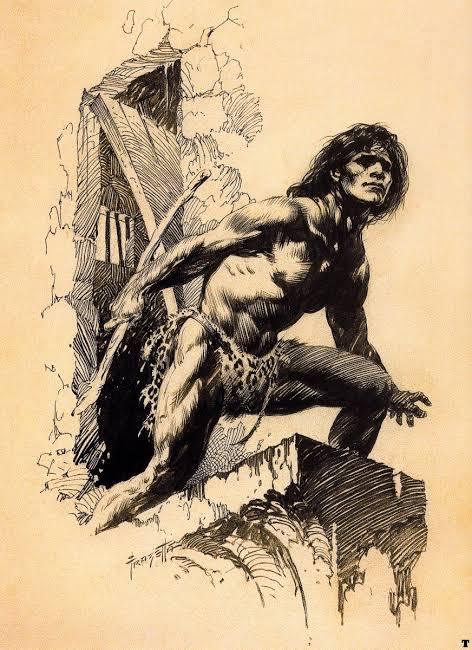
Claude Monet
Claude Monet is the main and most dedicated representative of the impressionist movement. He always preferred paintings outdoors, regardless of weather conditions,in order to capture all the effects of nature. Early in his career he was misunderstood, especially by his family, resulting in financial difficulties for years. Only around the age of 40 did he start selling his paintings, he died as a rich and well known artist.
He started to paint from a very young age which earned him some money, selling caricatures, with the money he bought painting materials. In 1858 he met Eugene Boudin, a landscape painter who encouraged him to paint outdoors. The following year he moved to Paris to specialize his techniques. At that time Paris attracted the most varied artists in the world and there Monet met Camille Pissarro and Manet among other avant-garde artists.
In 1874, the first impressionists exhibition was held in Paris, featuring works by Monet, Renoir, Degas and Cezanne. The term Impressionism, derives from Monet’s painting called Impression, Sunrise (1872).
It was the art critic Louis Leroy to call the artistic movement: Impressionism. It was a way of understanding this type of painting that did not follow the standards established by the academy and its realistic paintings.
When looking closely at an impressionist work, you see only separate brushstrokes that look like blotches without contour. Seen from afar, the brushstrokes organize for our eyes creating shapes and luminosity.
His works of art followed, as a main theme, the landscape of nature.
He worked harmoniously with colors and lights, creating beautiful and strong images. In the artistic context, is good to mention the series of paintings that he made on the Cathedral of Rouen (1892-1894), where the artist portrayed the constructions at different times of the day, with variations in brightness.
Monet and the impressionist artists, were no longer interested in themes related to the nobility, to the church, or to producing portraits that were true to reality. They wanted to see the painting as work in itself.
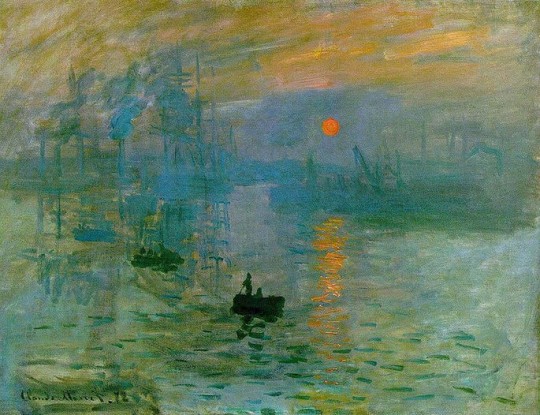

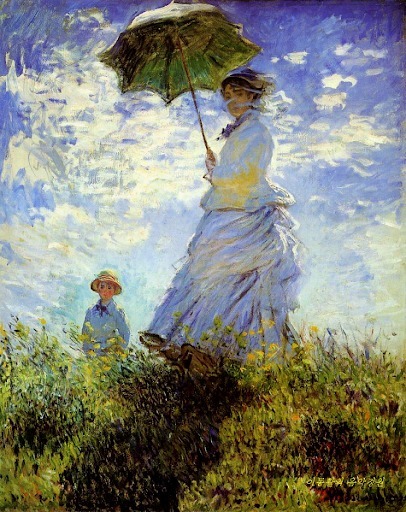
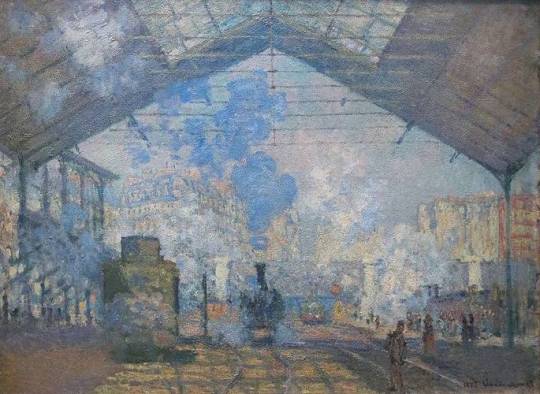
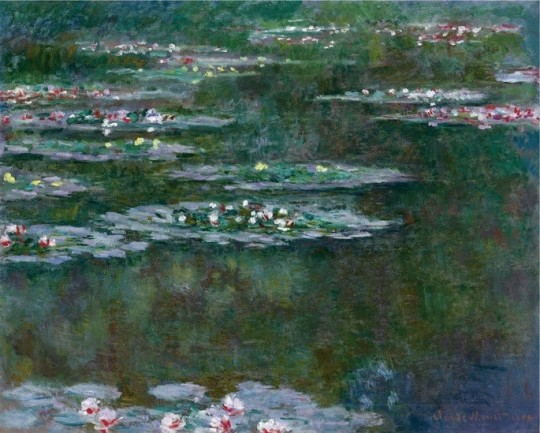
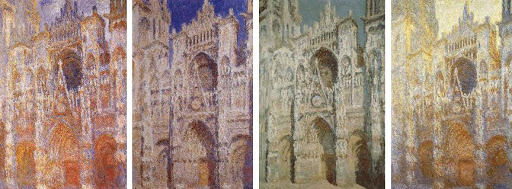
Ridley Scott
Ridley Scott is one of the most well-known film directors of all time. He made several films of different genres, but his most well-known genre is science fiction, making films like Alien, Blade Runner, The Martian and Prometheus.
But before before of being a director, Scott was applying to the Royal College of Art, one the most acclaimed art colleges at the time, to be a designer.
Scott always liked drawing , but he saw that he had no way of being a painter. His teachers always argued that his paintings were more illustrations than paintings.
So he saw that the Royal College of Art, had a particularly strong Graphic Design Department, which would give him a more specific creative target and a broader canvas. He was accepted by the college, and started his studies in 1958 and finished in 1961.
In his words, he considered design college to be extremely competitive, everyone in his class tried to compete with each other to see who was better. And Scott realized that he needed to fight hard to be among the best. “It could be very competitive, with no much being given away and everything kept close to you chest. You observed all the time, watched everyone else did and tried to do better and be the most original”.
Since graduating, Scott has said that he has become extremely perfectionist, and has tried to do as much of his work as a designer and a filmmaker in the best possible way.
After working as a set designer, and director in British television, he began in 1967 to direct commercials, eventually numbering more than 2,000 for his own company. His attention to visual stylization in his commercials, including distinctive atmospheric lighting effects, continued into the feature films that he began to directing in 1977.
In 1979 Ridley Scott releases what is considered his debut film and his masterpiece, the movie Alien. Starring Sigourney Weaver as Ellen Ripley, Scott is credited with having a heroine take point in the ensuing hunt aboard the Nostromo spaceship. Scott’s paintings and illustrations are close to pointillism with tiny points that result in images of high definition and extreme detail.
A highly detailed approach marks his style. His eye for composition, lighting, and design seems to explain his ability to visualize a movie in his mind. He claims to have and eidetic memory and the ability to recall images with high precision.
https://www.youtube.com/watch?v=tjD82nKybUA


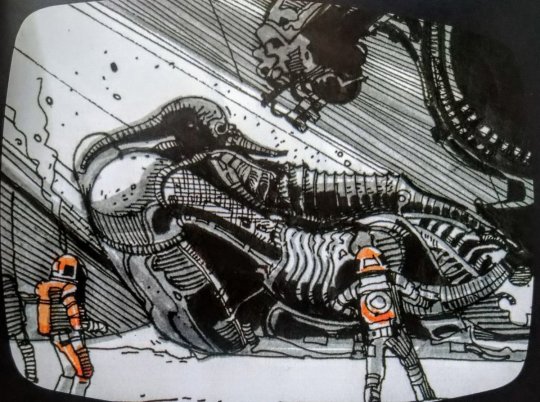
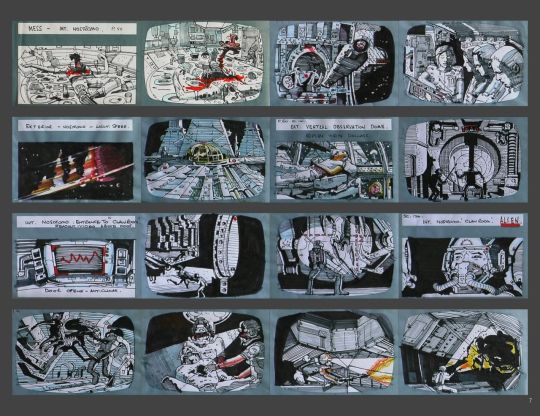
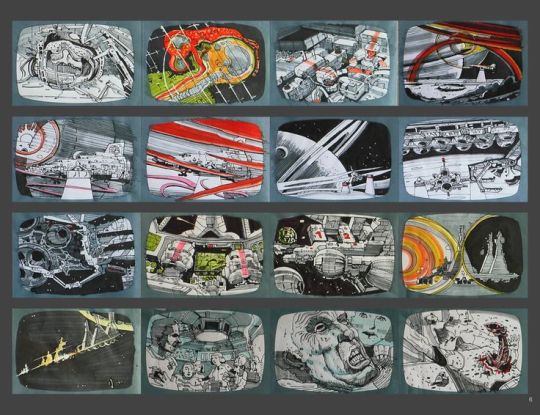
Roxie Vizcarra
Roxie Vizcarra is an artist, who worked as the senior illustrator of Rockstar Games, who worked closely on the iconic Grand Theft Auto v and Red Dead Redemption 2 marketing campaigns.
The Peruvian-American artist was just out of college- she earned her bachelor’s degree from the Parsons School of Design in New York- when she was approached by Rockstar games in 2009.
Vizcarra was Rockstar game’s first female illustrator. The first project she worked on was Grand Theft Auto IV: Liberty City.
The first game Vizcarra worked on since its inception was the original Red Dead Redemption, released in 2010.
Vizcarra draws her art from spaghetti western movies and holds the work of “Golden age” illustrators such as Bob Peak and Robert McGinnis in high regard.
For most of her career, Vizcarra’s process began by drawing in sketchbooks (she’s a fan of traditional ink), which she then uploads and adds digital colors through Photoshop.
However, for a year or two she has been using Procreate on the IPad, which is very flexible for her purposes. She also takes references photos when she doesn’t have a clear idea of what the illustration should look like, either of others or of herself, in the desired pose.
Vizcarra shows unusual humility; she insists on not taking credit for herself and repeatedly refuses to attribute specific drawings to one person or another, or to go into the why’s and how’s of illustrations.
Vizcarra’s work is really interesting, and it explores the more of the side of markenting. In making covers and posters extremely flashy for the public, and in addition to using references to posters from old western movies, maybe that is what attracts me the most. I really like the western theme, and I always liked the way she created the poster for games like red dead redmeption 2 and GTA, with extremely warm colors, with references of very old artists, who perhaps few remember, but she always tries to put some of them into her work.

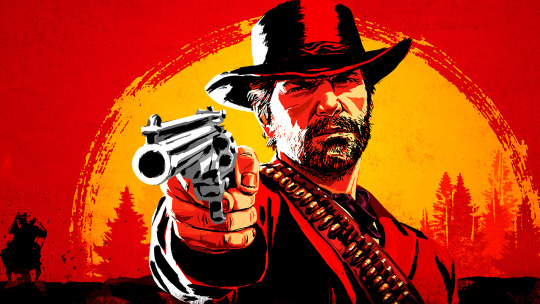

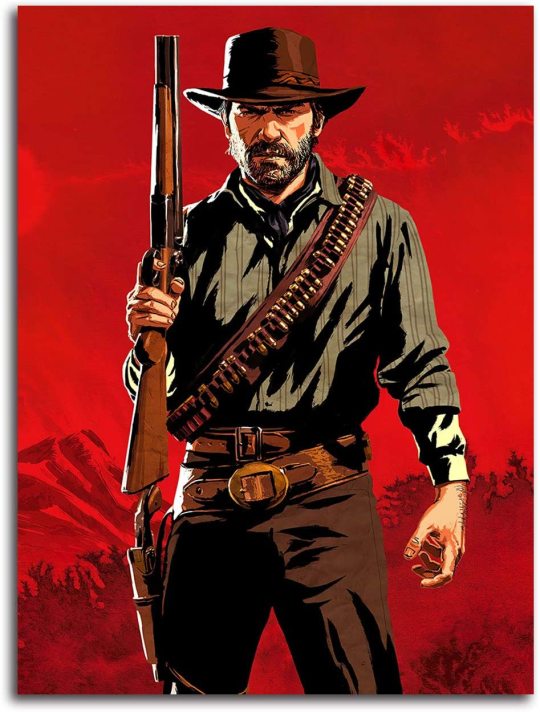


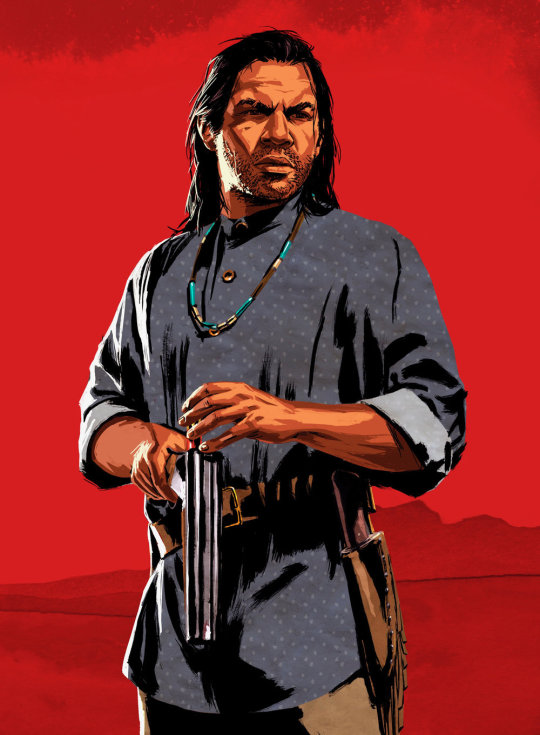
Show and Tell Digital Collage research
Terry Gilliam
Is a famous American-British director, screenwriter, animator, artist and comedian, and who is known for directing and acting in some of the films of the English comedy group Monthy Python, in addition to making films that are extremely difficult to understand, as if madness were the main character in all his films.
Terry Gilliam began his career as an animator and photographic cartoonist; one his first jobs was for the Help ! Magazine.
Gilliam preferred cut-out animation, which involved pushing bits of paper in front of camera instead of photographing pre-drawn cels. The process allows for more spontaneity than traditional animation along with being comparatively cheaper and easier to do. He also preferred to use old photographs and illustrations to create sketches that were surreal and hilarious.
Gilliam was one of the founders of Monty Python. At first, he was accredited as an animator ( his name appeared separate from the remaining 5 members in the credits), later he also joined the series as an actor. Their animations linked the sketches of the program and defined the group’s look in other types of media ( such as Vinyl discs, book covers and the opening sequence in the films).
Gilliam polished a unique style, created fantastic worlds, worked with great stars for the biggest studios, and sweated tight budgets to execute his vision, not always sharp but always brilliant.

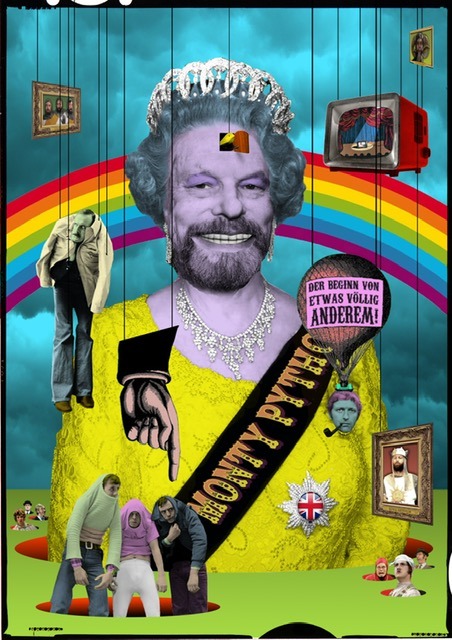

Caco Neves
Caco Neves uses digital collage as a platform, he created, for the past 10 years, illustrations for zines, magazines, advertising pieces, vignettes for TV and the web and, more recently, he was summoned by the Vogue art team to create the cover for the Vogue Experience 2017.
After spending a season in London, where he learned to give movement to his creations with the techniques calls Motion Collage, Caco returned to Brazil and, in a moment of creative rest, when he was creating for himself and not for a client, worked on a psychedelic vignette, then he sent it to MTV, to see if they liked the style, and they asked to use this commercial but to make some adjustments.
For Caco, the success of digital collage in the last decade is a reflection of the time we live in. “ The internet brought access to images- digital collections became public- and photoshop became popular.”
He has worked for several national and international companies, and his work is very dear to his collaborators, very much for his creativity, and for the choice of technique.
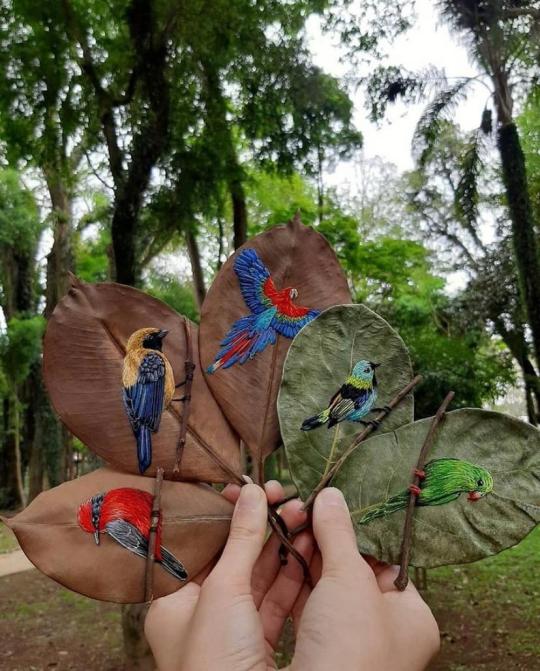

0 notes
Text
“Horror Vacui” or the fear of the blank page [for amateur artists]
[A really long post]
If you fit this description, this post is for you:
I’m a hobby artist/writer/creator with a broad interest and I don’t have enough to time to practice any of my interests beyond the amateur level. Creating is something I commit to about 10 to 15 times a year - when I need help, I don’t want to take an online course, just give it to me quick and dirty and I’ll see to the turnover.
This post contains:
mandatory motivation delineation
step-by-step drawing guide for amateur artists by an amateur artist
all reference pictures for the above
tracing - a technique shunned by my Grade 8 art teacher and the last time I attended art class
cross-hatching and contours
a tiny bit of perspective
a bit of shading
tools
tips for shaky hands
Why this post, when the internet has countless of tips to overcoming writers’/artists’/creators’ block already?
I mean, Google churns out some 20 million search results in under 0.55 seconds! That’s like 10 search results you are might look at tops - 20 if you’re desperate enough to go to page 2 - and realize most of the tips a lot of work, not worth the trouble, things you’ve tried before, or too abstract to be applicable to the thing.
One thing most of these guides get right: getting started is the most crippling step of the creative process.
The most common advice to overcoming your block - so I have read countless times - is establishing a routine until you “instinctively” know how to achieve your goal. Are they wrong? No, definitely not. Is it good advice though? Depends; at least not for me - and if you’ve read this far, then not for you either.
What are my other options?
Planning. And being aware of all the tools at your disposal. I documented the process of this drawing as an example. This process has limited applicability to paintings.
You will need:
an idea
drawing utensils
paper (some scraps to start with)
patience
Step 1: Rough Sketching
Take scrap paper. Unless your documenting this (hi, mom) you’ll throw this away asap. Get down the rough shape. This may a while and will involve you questioning your sanity - barge through the doubt, don’t erase what you’ve made, use the best parts and try again.
Example:
I would like to draw a cat. I take a pencil and...
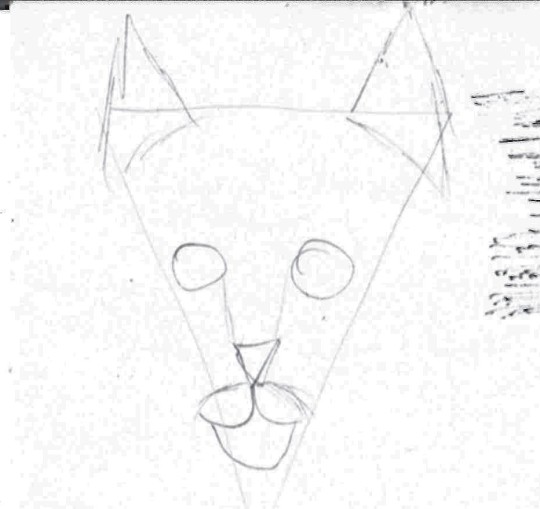
Lol, no. Cats are not pizza with ears.
Let’s try that again. Maybe a reference picture will help.

Much better. Start with some crude shapes but sketch out the entire body with shapes like they do in some drawing guides - only draw what you need. In this case about two and a half ovals are enough. Now make a better copy beside that initial sketch - I hate doing them on top of the first because that gets messy real quick. Draw some helping lines from the reference image. Don’t bother too much with proportions or posture, or going big; all these sketches are about 6 by 4 cm.
I want to draw a companion for this steampunk cat, about the same shape and posture with a head tilted one way and the torso another. She’ll need a proper headdress too - I went through three options visually and added some notes for other ideas I had in case neither of these worked out.
Step 2: Break it down
Break down the drawing into smaller bits and pieces and look up reference images if you need them.
I broke down my sketch into:
Head/Face
Torso/Clothes
Hat
Fan
The head
I want my cat to look slightly to the left and this is what I found online:
Not quite
Almost
Perfect
The torso
I found this image, which contained most of the parts I needed. I didn’t like the hat, head, fan, and all the mice scampering about ‘er so I just took the torso - the corset is really neat. Unfortunately, her posture is not quite what I need so that will be the biggest challenge for this body part.
The hat
I considered a few options such as this 1920s flapper’s headpiece and a couple of Victorian hats before settling on this one.
The fan
I own two so no reference image necessary.
You can keep a couple of tabs (or books, if you have some at hand) open in case you change your mind while drafting.
Step 3: Fine Sketching
This is the hardest part but if you’ve made it this far, you might as well go all the way, right? Understand how your brain operates and beat it at its own mind-game: create a sunk-cost-fallacy and drive yourself forward.
There three ways to get your fine sketch onto paper:
Cool, if you can pull it off go for it, usually takes the longest if you lack the practice (like I do)
Generally a good approach, especially when scaling up
Use a ruler to measure and plot key points of your outline
Print it and hold it against a window.
If it’s dark outside unhinge that glass cabinet door, duct tape it between two tables and put a lamp beneath.
Pull it up on your screen and adjust your zoom. Be careful with the pressure of your pen!
Use sticky tape to prevent it from slipping
(Below) Using a reference grid (the dots) on a canvas for another project.
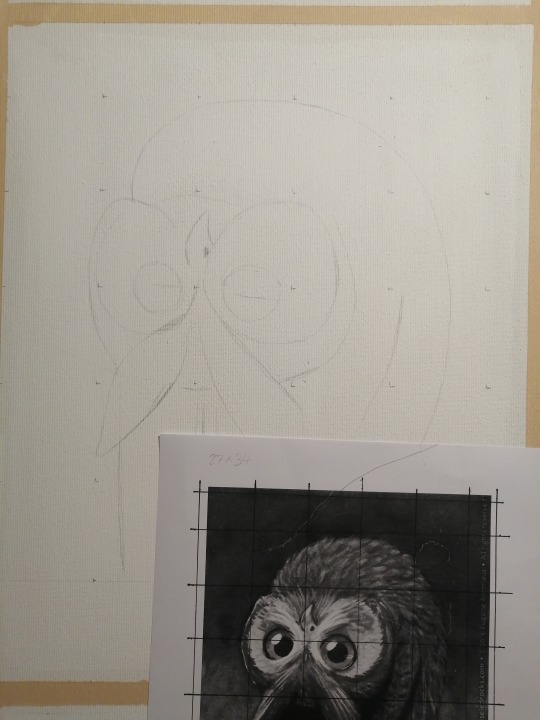
(Below) Tracing the head. Slight rotation of the page to achieve the desired orientation of the head.
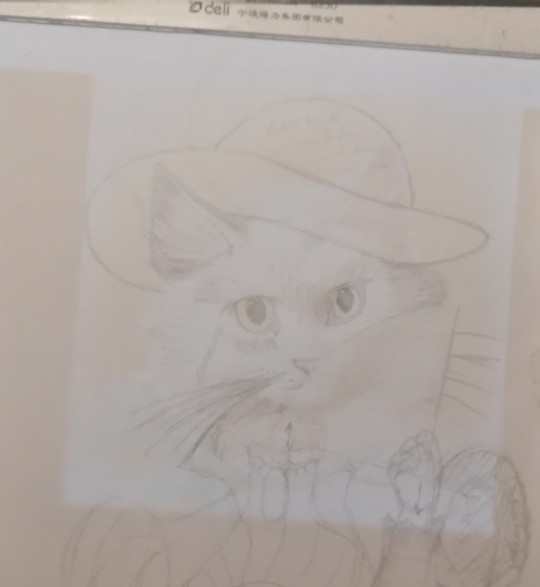
I also traced the torso and the head first. Then I added some rough shapes for the arms and the fan - this was also when I realized I can use the fan to hide parts of the face I don’t want to draw. Everything ended up a little twisted and short so I dashed lines where I want these limbs to go. The fabric of the corset also needs to be pulled up on the right and pushed down on the left, hence the arrow there. The neck is way too long too. Add some more notes of things you want to change - like adding a fuck-ton of flowers to the hat.
To judge whether the proportions make sense take a look at yourself in the mirror or ask random people in the hallway to pose for you - afterwards exchange a friendly, confused smile and move on.
(Below) First fine draft after about 5 hours of intermittent work - just take breaks when you’re bored, but leave it prominently lying in your way so you don’t forget about it. I reconstructed the arms’ outlines and added some bold comments.

Once you have everything you need, clean up your first draft as much as possible by erasing help lines and drawing strong borders. Next, open something bright on your screen (or whatever your tracing equipment happens to be), tape a blank paper to your first sketch and take down all the details you want to keep. You can move the paper around to shorten or elongate distances.
Add borders if you want to frame the drawing later.
Now change all the things you don’t like. I changed the cat lady’s hat to be less round because I didn’t want her to wear a wide-brimmed bowler and added a fuck-ton of flowers and - for good measure - a feather. If you can’t draw the feather flicking back up like me, hide it behind the brim of the hat.
Think about any fur you want interacting with the fabric (hat or collar). I added one curl to flow down the left side of her collar - didn’t really work out but A for effort.
Add any major decorative elements like the fish on her corset or the patterns on her fan.
Add major textures like the lines on the brim of her straw hat. The dotted texture on her sleeve was way too fine and didn’t carry over to the next tracing. The same goes for the shading from the last draft, which didn’t carry over well and I ended up bundling all the fur together in larger bundles.
Save the puffy shoulders for last (because I had no idea what to do there and eventually opted for “brains”).
(Below) About 90 minutes on the face to compartmentalize all strands of fur into proper bundles. Note six key bushels that define her expression: on both side of her nose, her “eyebrows” and the trailing of her eyes. Look up cartoon cats for help. 2 hours on her torso and another hour on her shoulders.
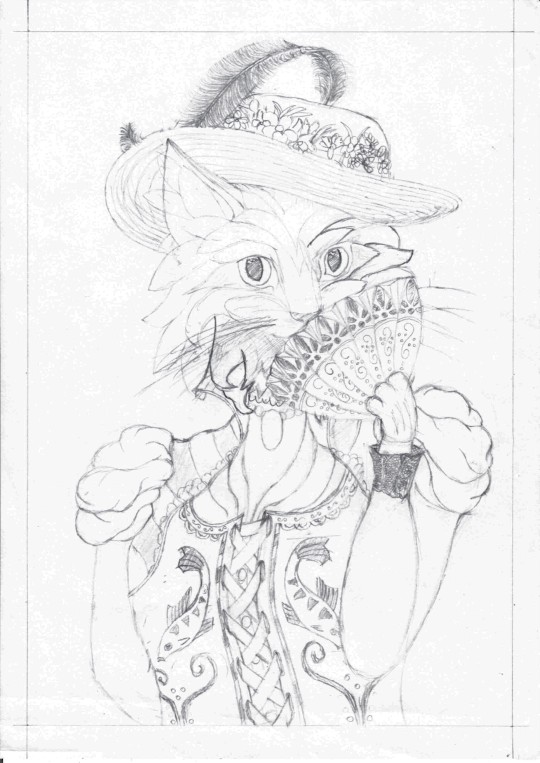
Clean it up again and judge your work. If you are still unhappy with the positioning, do another tracing. Don’t forget to embolden all important features
Step 4: Inking the outline!
You’re patience is paying off! Next up is inking! Inking is fun!
Oh shit-
Don’t ink your final draft!
Step 4a: Screw up
I never get my inking right on the first try and it’s hard to hide mistakes you made with ink. I ran my draft through the photocopier once (because I didn’t want to trace it) so my mistake here wasn’t that big a deal - I lost five minutes and this paper went into the my scrap tray. Always start inking the most difficult part so you don’t regret screwing up after being almost done.
At this point I realized I couldn’t erase the pencil lines anymore and went back to tracing paper on paper on screen. Be aware of the ink you use and how thick your paper is or you might end up leaving marks on the draft below.
(Below) The pattern on her brow is off in two places.
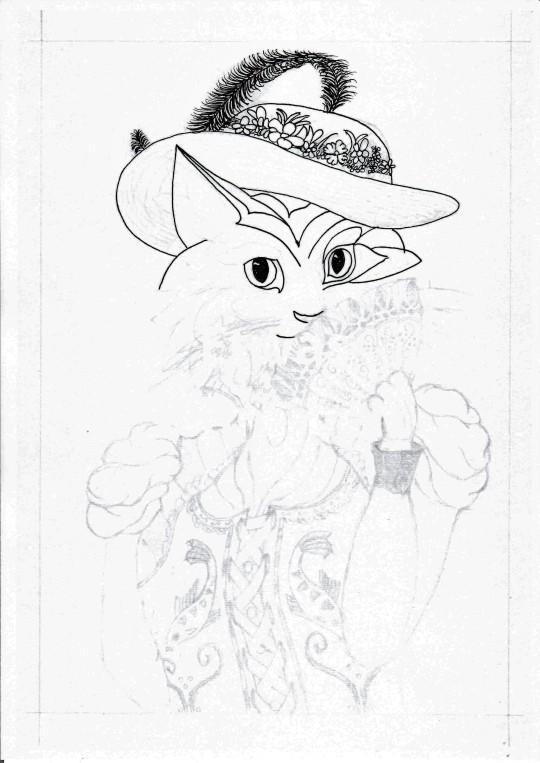
Step 4b: Finish inking the outline
As before focus on borders and major textures; about now you’ll notice which parts of your draft are to fine to trace well and which ones need some extra weight. Drop any lines you don’t like.
By now you probably have a couple of pages with sketches and bad inkings lying around - make sure you label them or find some other method to remove them from your line of work (like throwing them in the bin).
(Below) About 45 minutes, 5 of which were spent on the feather, 5 on the flowers, 10 on the fan, 10 on the face, and 15 on the torso including arms.

At this point you could scan and stick it into a colouring book.
Step 5: Textures!
This is the best part. Texturing a drawing is so satisfying it makes up for all the hardship up to this point.
Make a couple of copies this time to practice your texturing. Afterwards, feel free to continue the page you traced or run it through the photocopier once again.
(Below) Two versions with different types of shading.
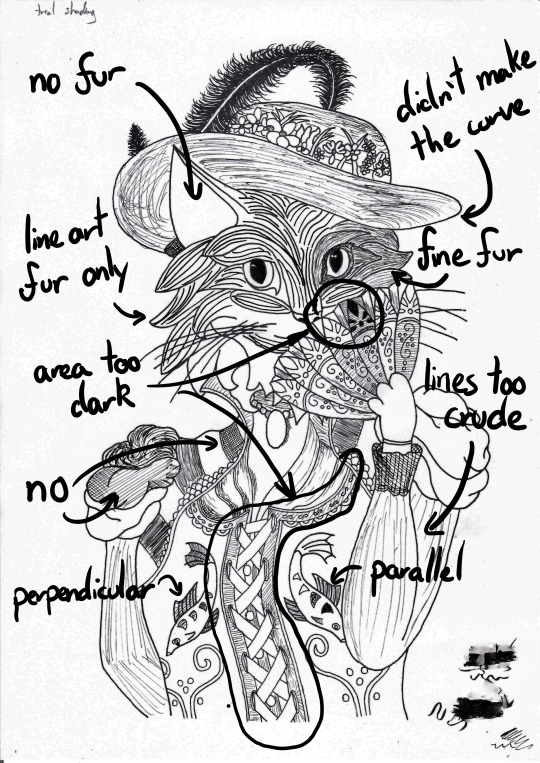
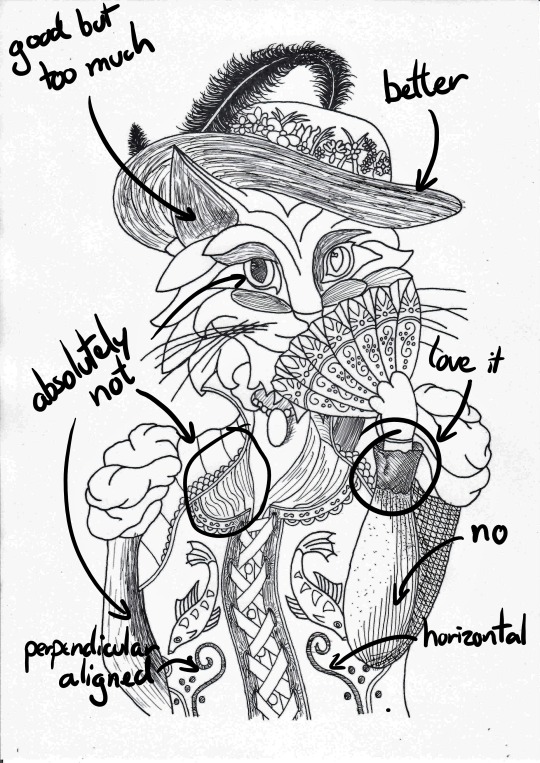
It’s very easy to get carried away when shading; always go for a little less than you think you need. You can always add more later, but you can’t take it away.
Fur
Use lines that flow parallel to the outlines you’ve already drawn. Make the strands flow apart at the beginning and back together at the end. Try to keep the numbers of strands that begin and end constant. This will result in a larger spacing and thus a lighter centre of your bushel.
I like shading an entire area, in this case the entire head uniformly but very lightly, then I start thinking about accents and where light could come from. Wherever fur bundles together (usually at the end of a bushel) I add some more of the same texture to make it darker. You can lift some of the shading from your reference pictures and just copy it. But don’t limit yourself to what your references provide.
To be honest, I only roughly take notice of where I place my imaginary source of light and just emphasize parts of a bushel that were darker to begin with. Usually turns out okay.
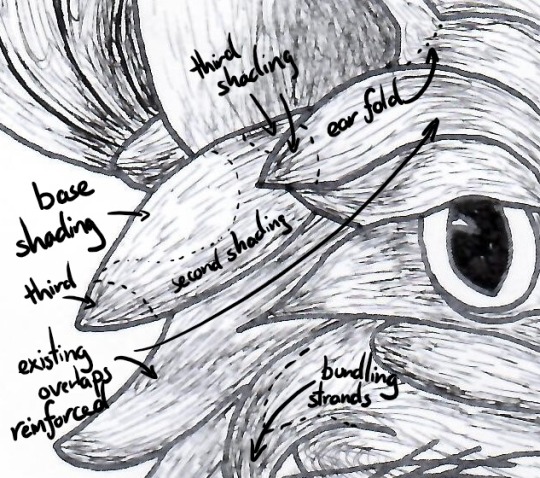
Fabric
Generally, keep your texturing parallel, perpendicular or at a fixed angle to the next leading edge. The lines don’t have to be - and most of the time shouldn’t be - straight. Allow them to trace out wrinkles in your fabric or reinforce the fabric’s rigidity by copying the leading edge at short intervals.
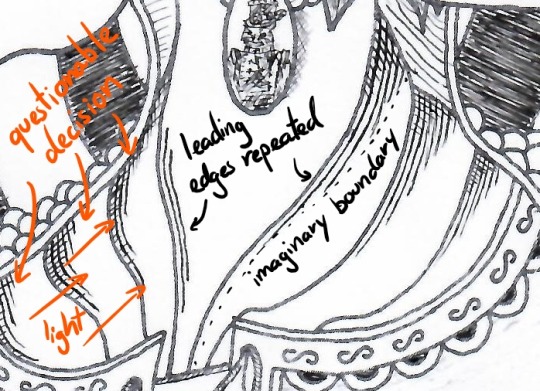
The same formula of repeat the leading edge applies to other parts of the clothing - just vary the line separation and how strictly you follow the leading edges.
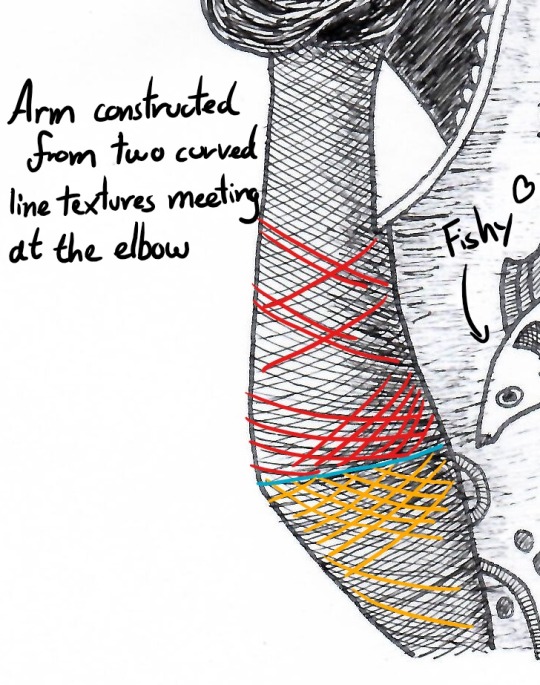
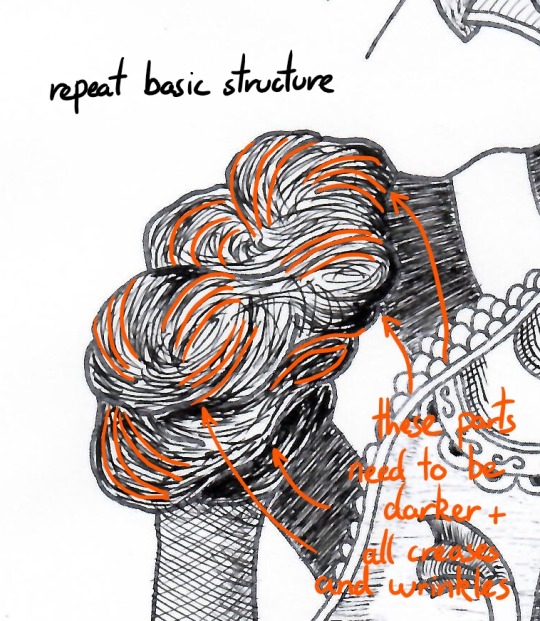
In other places lines placed at constant angles make a good texture.
Know your tools: my pens stop drawing at an angle of about 30-45° and drawing lines at this angle will make them lighter and discontinuous. This is a good approach to lightly shading a large area like most of the corset.

Cross-hatching gives the sleeve a wrinkle and two light-spots. Two layers at roughly 70-90° gives a good hatch, only add a third layer if you need it really dark - careful: this will make any contours established with two layers disappear.
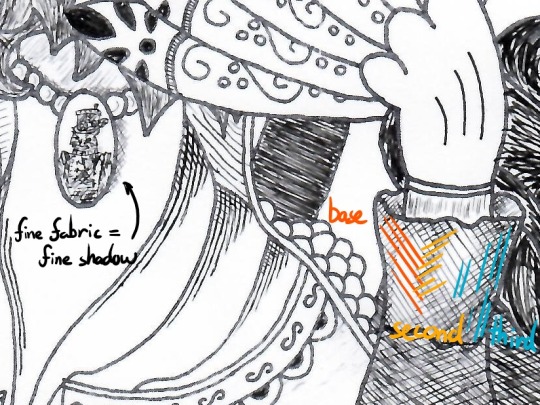
Shadows
Some places just ought to be darker though, like the spot I marked behind the ear or below the chin. This gives your drawing some depth. Just reiterate the same local texture over and over again until it’s dark enough.

Without my annoying comments, the final result will look like this:
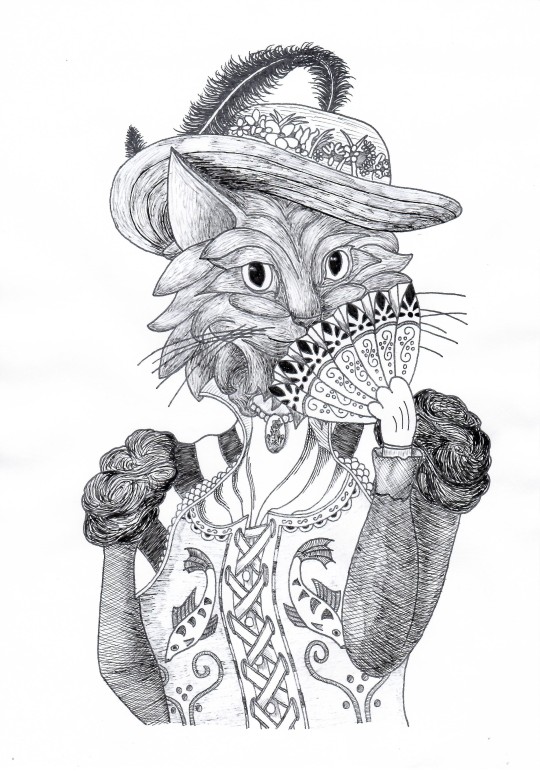
Is it perfect? Fuck no. Is it pretty good? Aye, meets my standards.
By the way, this is what we started with:

Tips for shaky hands
Sugar, caffeine, medical condition? Hands come in all degrees of shaky but don’t let that discourage you. Here’s how I approach the most important elements in my art.
Long lines
Long lines are hard to draw, if you don’t have practice sliding your hand across the page. I can do it sometimes but not reliably. Instead I place my wrist firmly on the page and draw the part of the line that is within my mobile range. The more of my wrist rests on the page, the less I shake. Then I lift my pen and move on to the next bit - sounds trivial?
Wrong.
Whenever you start or end a line you go from rest to drawing speed or vice versa. During these moments the constant flow of ink is spread over a shorter distance, resulting in a thicker line. Appending a new segment causes a brief overlap and results in a blotch, especially when you need longer than an instant to correctly put down your pen.
Coming in at an angle prevents the ink from flowing prematurely and gives you more control of your line.
Curved lines
Place your wrist on the inside of the curve (segment) - drawing towards yourself is easier than away. Rotate the page to make it happen or rotate yourself if the page is stationary (like a large canvas). Additionally, I like to keep my fingers stiff and only rotate around my wrist.
Textures
For very fine textures I keep the tip of my pen above the page and start repeating the pattern. About two thirds of the strokes will go into thin air but the shaking will make one third hit the page - a statistical approach to texturing.
Conclusion
My longest post so far - I starting making this almost 8 hours ago. A blank page is a scary thing, so many possibilities, so many ways to screw up. The most important advice to take from this post is plan, save, trace, repeat. You don’t have to be ashamed for tracing art; just don’t parade an exact copy as your own work and always keep your references at hand.
Why does this feel like academic writing 101...
I invite anyone to contribute their own quick and dirty drawing tips for amateurs to this post. DM me, if you have any questions or would like to use this a last-minute-Christmas gift - I’ll send you a free high-res. I don’t judge, not this year nor any other.
Best, Ocelittle
#tutorial#art tutorial#artists on tumblr#ink#ink drawing#drawing#art#amateur art#christmas gifts#horror vacui
0 notes